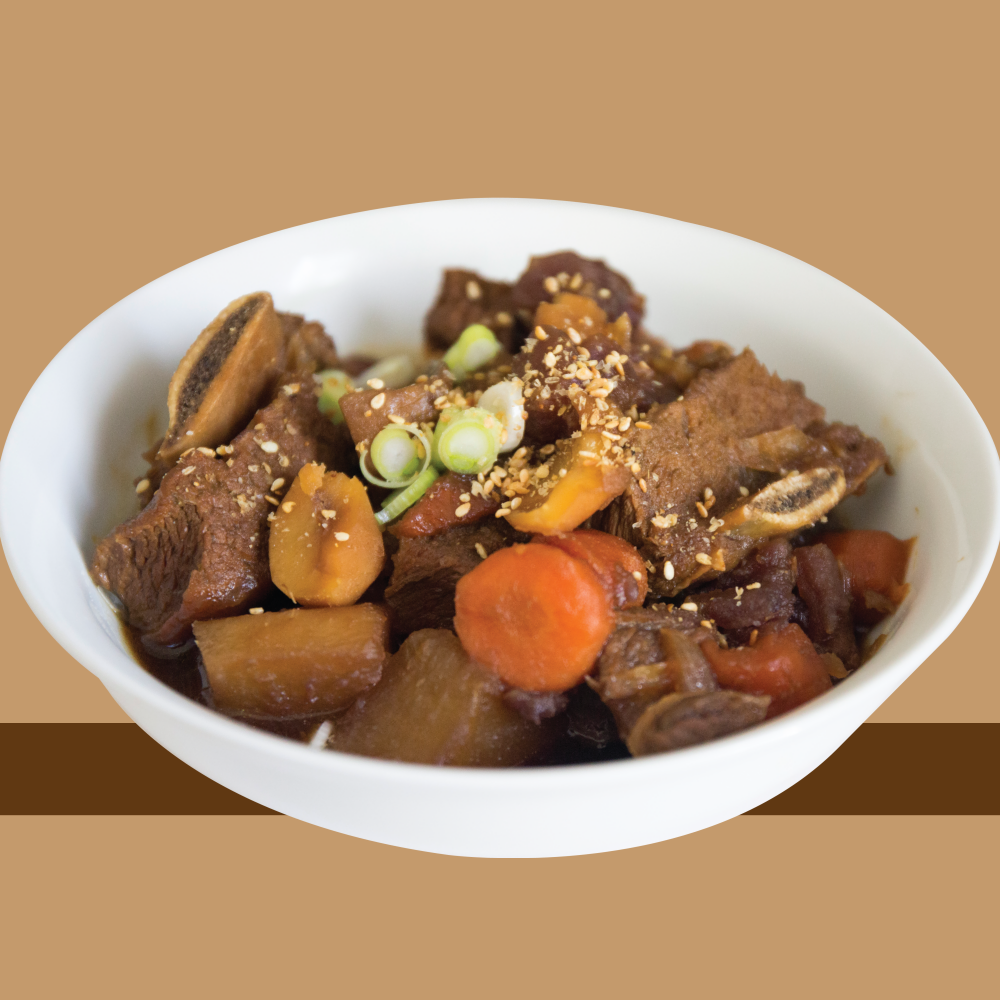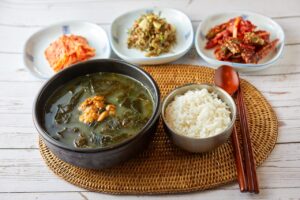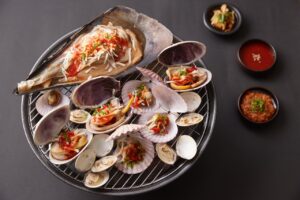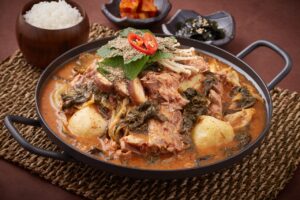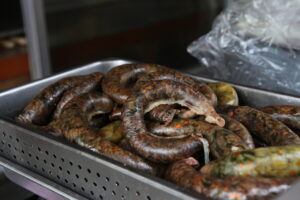-
Tteokguk, you will be one year older Oct 2023.
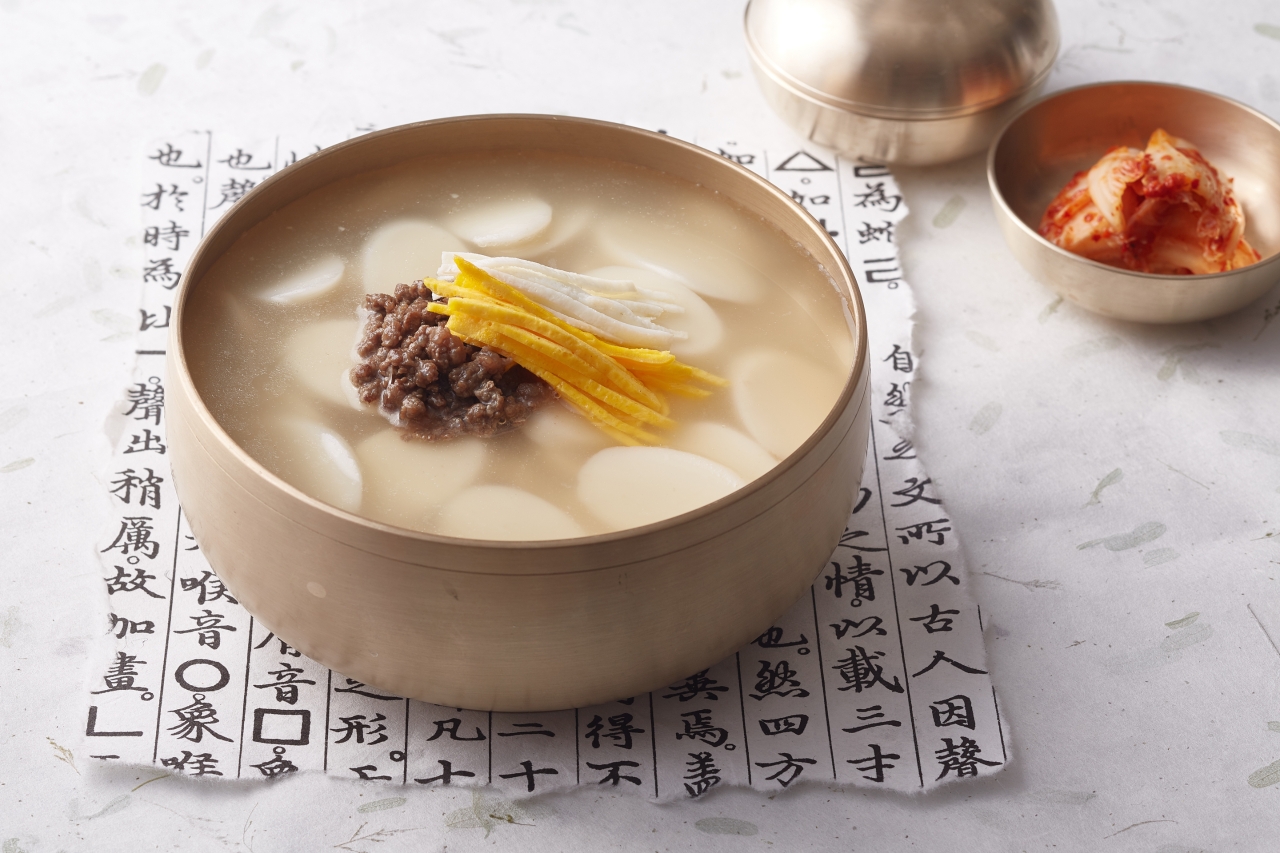
Meaning of Tteokguk in Korea?
The phrase “If you eat tteokguk, you will be one year older” is a traditional saying in Korea that is associated with the custom of consuming tteokguk (rice cake soup) on Korean New Year’s Day (Seollal). It reflects the cultural and symbolic significance of tteokguk in Korean traditions.
In Korean culture, age is highly respected and celebrated, and the concept of gaining a year of age is a central part of this tradition. On New Year’s Day, everyone in Korea is considered to become one year older, regardless of their actual birthdate. This practice is known as “Korean age” or “man-nai” (만나이).
Eating it on New Year’s Day is not only a culinary tradition but also a way of symbolizing this age increase. It is believed that by consuming tteokguk, a person is ceremonially marking the passage of another year and is wishing for good luck and a prosperous future. Therefore, the saying “If you eat tteokguk, you will be one year older” reflects the belief that participating in this tradition is a way to start the new year on the right foot, ensuring blessings and longevity.
This custom is deeply ingrained in Korean culture and is a beautiful example of how food, tradition, and symbolism are intertwined in the customs of a particular society.
What is Tteokguk?
Tteokguk, also known as ddeokguk or tteok guk, is a traditional Korean soup made primarily with rice cakes called “tteok” (떡). This dish is a staple in Korean cuisine and has cultural significance, often associated with the celebration of the Korean New Year (Seollal).
Key features of tteokguk include:
- Tteok (Rice Cakes): The primary ingredient in tteokguk is rice cakes, which come in various shapes and sizes. They symbolize good luck and are said to bring good fortune for the coming year. The tradition of eating tteokguk on New Year’s Day signifies gaining a year of age.
- Broth: Tteokguk is prepared with a clear, savory broth, which is typically made by simmering beef, such as brisket or flank, along with various seasonings and aromatics. The broth is essential for flavoring the dish.
- Garnishes: Tteokguk is often garnished with additional ingredients like thin strips of cooked beef, scrambled eggs, seaweed (usually thinly sliced strips of toasted seaweed), and chopped scallions. These garnishes provide additional texture and flavor to the soup.
- Seasonings: The broth is seasoned with ingredients like soy sauce, garlic, and sometimes sesame oil to enhance the overall flavor.
This is considered a comforting and symbolic dish, with its consumption on New Year’s Day being a tradition that is deeply ingrained in Korean culture. The act of eating it is not only a culinary tradition but also a way of celebrating the beginning of a new year and paying respect to one’s ancestors and heritage. It’s a beloved and meaningful part of Korean cuisine.
History
A traditional Korean rice cake soup, has a history deeply rooted in Korean culture and tradition. While the exact origins of tteokguk are difficult to trace, it has been a significant part of Korean cuisine for centuries. Here’s a brief overview of the history of tteokguk:
- Ancient Origins: Rice has been a staple in Korean diets for thousands of years, and rice cakes (tteok) have been made in Korea since ancient times. Tteok was used for various purposes, from offerings in ancestral rites to everyday meals. The practice of making and consuming rice cake soup likely dates back to early Korean history.
- Symbolism: Tteokguk has long been associated with symbolism and rituals. The round shape of the rice cakes symbolizes the sun and the cycle of life, and eating tteokguk on the Korean New Year (Seollal) has been a tradition for centuries. It’s believed that consuming tteokguk on New Year’s Day brings good luck and represents the wish for a prosperous and healthy year ahead.
- Cultural Significance: Tteokguk is not only a culinary tradition but also a cultural one. In Korea, there is a strong emphasis on age and respect for one’s elders. Eating tteokguk on New Year’s Day signifies that a person has aged another year and is a way of showing respect for one’s elders. It’s a practice that fosters family togetherness and the preservation of traditions.
- Variations: Over the years, various regions of Korea have developed their own variations of tteokguk. These variations can differ in terms of ingredients, preparation methods, and flavor profiles. Each region may have its unique twist on this classic dish.
- Year-Round Dish: While tteokguk is closely associated with New Year’s celebrations, it is enjoyed throughout the year in Korea. Some people eat it as a comfort food or special dish for birthdays and other important occasions.
In summary, tteokguk is a dish deeply ingrained in Korean culture and tradition. Its history is tied to the symbolism of rice cakes, the celebration of the New Year, and the values of respect and family. It remains a beloved and meaningful part of Korean cuisine, passed down through generations.

Tteokguk ⓒ한국관광공사 사진갤러리-알렉스 분도 Cooking Method
Tteokguk is a traditional Korean rice cake soup typically enjoyed during the Korean New Year, but it can also be made and enjoyed throughout the year. Here’s a basic recipe for making tteokguk:
Ingredients:
- 1 cup of sliced tteok (rice cakes) – You can use cylindrical or oval-shaped tteok.
- 6 cups of beef or chicken broth
- 1/2 pound of thinly sliced beef (such as brisket or flank steak)
- 2 cloves of garlic, minced
- 2 teaspoons of soy sauce
- Salt to taste
- 2 large eggs
- 2 sheets of toasted seaweed (gim), cut into thin strips
- 2 green onions, chopped
- Sesame oil (optional)
- Black pepper (optional)
Instructions:
- Prepare the Rice Cakes: If the rice cakes are hard, you can soak them in cold water for about 30 minutes to soften them. Drain before using.
- Make the Broth: In a large pot, bring the beef or chicken broth to a boil. Add the minced garlic and soy sauce to the broth. Season with a bit of salt to taste. You can adjust the saltiness later if needed.
- Cook the Beef: Add the thinly sliced beef to the boiling broth. Cook for a few minutes until the beef is no longer pink and has cooked through. You can skim off any impurities that rise to the surface.
- Add the Rice Cakes: Gently add the sliced rice cakes to the boiling broth and cook them for about 5-7 minutes, or until they become soft and chewy.
- Prepare the Garnishes: While the rice cakes are cooking, prepare the garnishes. Beat the eggs in a bowl and make a thin omelet. Then, cut the omelet into thin strips. Also, chop the green onions and cut the toasted seaweed into thin strips.
- Assemble the Soup: When the rice cakes are soft, taste the broth and adjust the seasoning if needed with more salt. If you like, you can add a touch of sesame oil and black pepper for extra flavor. Remove the pot from the heat.
- Serve: Ladle the tteokguk into individual serving bowls. Garnish each bowl with the egg strips, green onions, and toasted seaweed.
- Enjoy: Tteokguk is traditionally served hot and can be enjoyed with kimchi or other side dishes.
This is a basic recipe for making tteokguk. Variations of tteokguk exist, with some recipes incorporating different ingredients like vegetables or seafood. You can also adjust the flavor to suit your personal preferences. Remember that tteokguk is not just a delicious soup but also a meaningful tradition in Korean culture, especially when enjoyed on New Year’s Day.
Recommend to Read >>>Bindaetteok, famous street food in Gwangjang sijang Aug 2023.
-
Seolleongtang, A Bowl of Korean Comfort. Sep 2023.
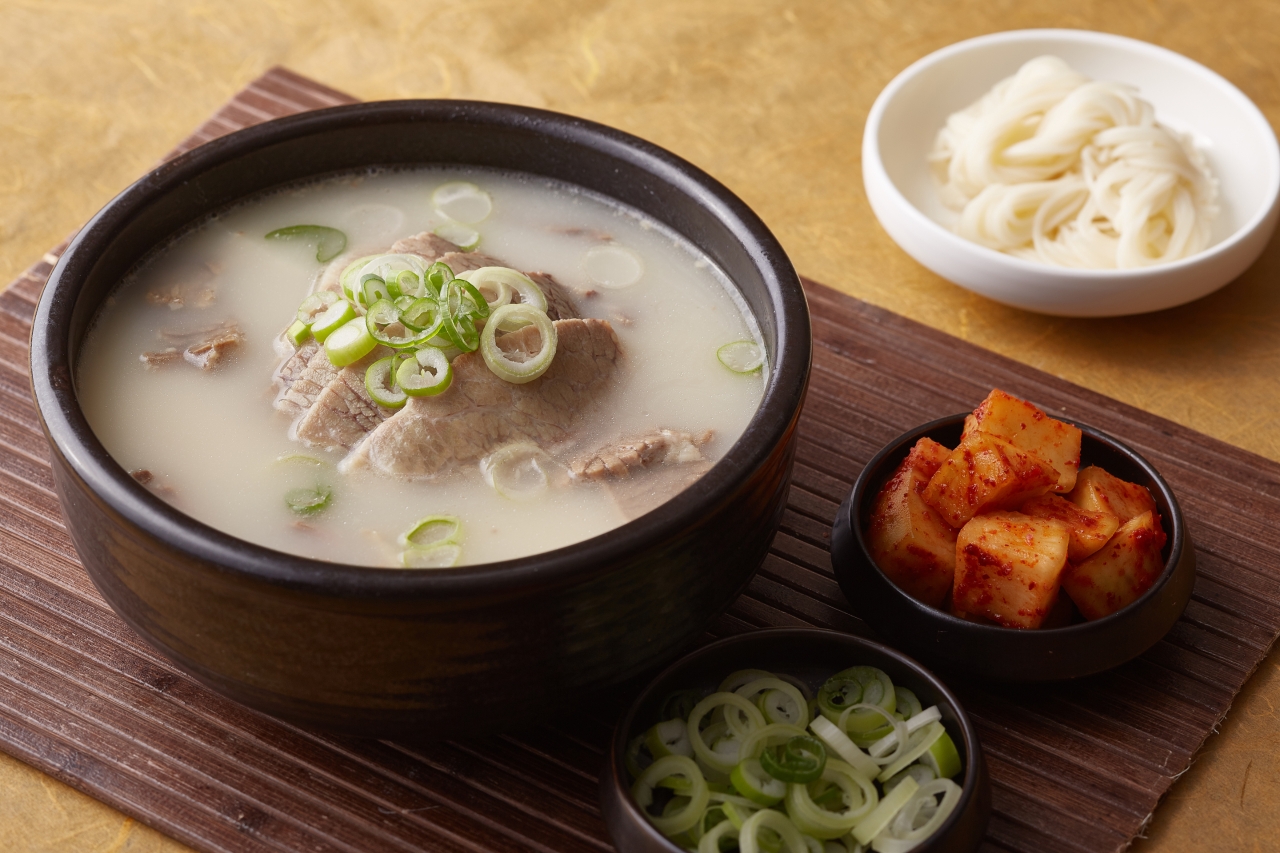
Seolleongtang, A Bowl of Korean Comfort.
Introduction:
When it comes to comfort food, few dishes can rival the soothing, nourishing qualities of Korean Seolleongtang. This unassuming bowl of soup holds a special place in the hearts of Koreans, offering a taste of tradition, warmth, and culinary heritage.
The Simmering Craft:
At its heart, Seolleongtang is a humble dish crafted from beef bones, patiently simmered for hours. The magic happens as the bones release their essence into the broth, creating a velvety, milky elixir. Leg bones and ox tail are the stars of this show, their marrow and collagen infusing the soup with richness and depth.
A Symphony of Simplicity:
Seolleongtang’s beauty lies in its simplicity. The broth is mild, almost ethereal, with a gentle sweetness from the bones. It’s seasoned with a touch of salt, allowing the natural flavors to shine. Yet, it’s a canvas for customization – diners often personalize their bowls with garlic, scallions, salt, and black pepper.
The Noodle Connection:
While Seolleongtang is a satisfying soup on its own, it often finds companionship in noodles. Somyeon (thin wheat noodles) or kalguksu (knife-cut noodles) gracefully join the broth, turning a bowl into a complete meal.
The Healing Elixir:
Beyond its taste, Seolleongtang is renowned for its potential health benefits. Collagen-rich and nutrient-packed, it’s a go-to choice when people need nourishment or are recovering from illness.
A Taste of Tradition:
Seolleongtang isn’t just a meal; it’s a vessel for tradition and family. It’s the steamy bowl that brings generations together, evoking cherished memories of cozy gatherings and shared stories.
Conclusion:
So, if you’re seeking comfort in a bowl, consider Seolleongtang. It’s more than a dish; it’s a warm embrace, a connection to the past, and a reminder of the simple joys that food can bring.
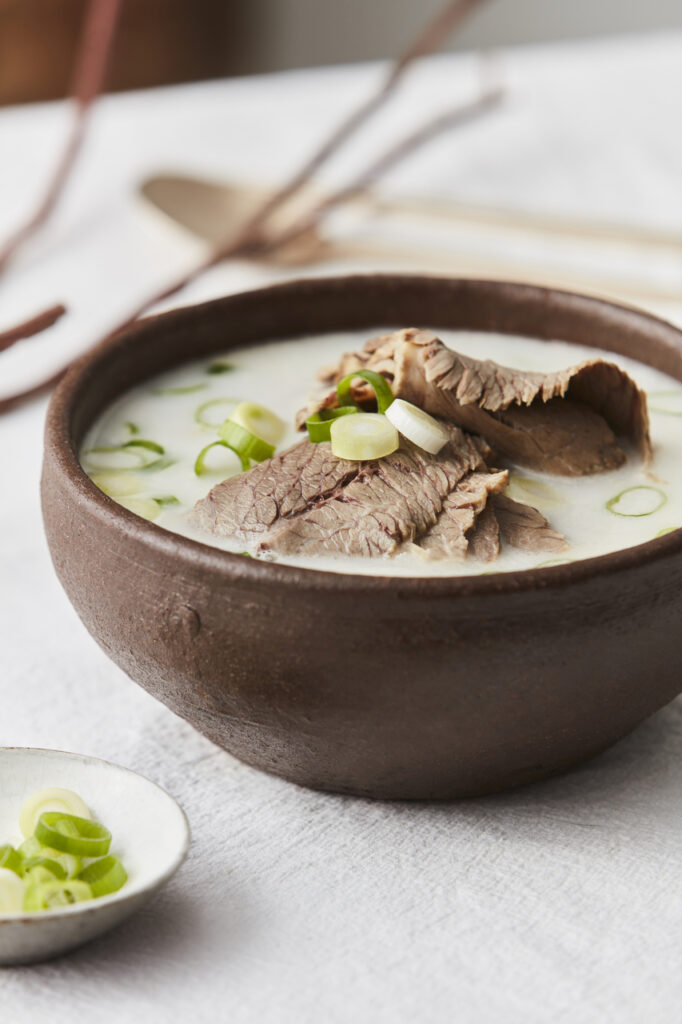
seolleongtang dish ⓒ한국관광공사 사진갤러리-알렉스 분도 History of Seolleongtang
Seolleongtang, a beloved Korean soup, has a rich history that spans centuries and is deeply rooted in Korean culture. Here’s a brief overview of the history of Seolleongtang:
Ancient Origins: The origins of Seolleongtang can be traced back to ancient Korea, where it was initially referred to as “seolratang” during the Goryeo Dynasty (918–1392) and “sollongtang” during the Joseon Dynasty (1392–1897). This soup was created as a way to utilize every part of the animal, especially during times when resources were scarce. The use of beef bones, particularly leg bones and ox tail, was common in Korean cuisine, and Seolleongtang emerged as a way to maximize their nutritional value.
Simple and Humble Beginnings: Seolleongtang was originally a simple and humble dish made by simmering beef bones for an extended period. This allowed the bones to release their marrow, collagen, and nutrients into the broth, creating a nourishing and hearty soup. In the past, it was often consumed by laborers and commoners as an affordable source of sustenance.
Culinary Evolution: Over time, Seolleongtang evolved, incorporating additional ingredients and variations to enhance its flavor. While the basic recipe remained true to its roots, variations began to appear, with different regions of Korea adding their own unique twists and ingredients to the soup.
Cultural Significance: Seolleongtang holds a special place in Korean culture as a comforting and restorative food. It is often enjoyed during cold winters or when individuals are feeling weak or unwell. Many Koreans have fond memories of enjoying Seolleongtang with family and friends, often garnishing it with their preferred seasonings and condiments.
Modern Adaptations: In modern times, Seolleongtang is still widely enjoyed in Korea and has also gained popularity internationally as Korean cuisine becomes more recognized worldwide. It is appreciated not only for its taste but also for its potential health benefits, particularly due to the collagen-rich broth.
Today, Seolleongtang remains a symbol of Korean culinary heritage, offering a glimpse into the simple and nourishing dishes that have sustained generations of Koreans. Whether served in traditional restaurants or enjoyed as street food, Seolleongtang continues to provide comfort and a connection to Korea’s culinary past.
Key Features
- Ingredients: The primary ingredients for seolleongtang are beef bones, including leg bones and ox tail, as well as brisket or other beef cuts. These bones are boiled for hours to create a rich, milky broth.
- Simmering: The hallmark of seolleongtang is the lengthy simmering process, often lasting several hours or even overnight. This extended cooking time allows the bones to release their marrow, collagen, and minerals into the broth, resulting in a creamy and flavorful soup.
- Mild Flavor: Seolleongtang has a mild and slightly milky flavor, with a hint of natural sweetness from the bones. It’s typically seasoned with salt and sometimes served with additional condiments and seasonings.
- Toppings and Condiments: Seolleongtang is often served with various accompaniments, including finely sliced scallions, minced garlic, salt, black pepper, and sometimes kimchi or spicy condiments. Diners can customize their soup to taste by adding these condiments.
- Noodles: While seolleongtang can be enjoyed as a soup on its own, it’s also common to serve it with noodles. The addition of noodles turns it into a heartier meal. The noodles used can vary but are often wheat-based noodles like somyeon (thin wheat noodles) or kalguksu (knife-cut noodles).
- Banchan: Seolleongtang is typically served with banchan, which are small side dishes that complement the meal. Common banchan include kimchi, pickled vegetables, and radish kimchi.
- Health Benefits: Seolleongtang is valued for its potential health benefits due to the nutrients and collagen-rich broth it provides. It’s often consumed when people are feeling weak or recovering from illness.
Cooking Method
Ingredients:
- 2-3 pounds of beef leg bones (such as marrow bones)
- 1 pound of beef brisket or other beef cuts
- 2-3 pieces of ox tail (optional)
- 10 cups of water
- 1 large onion, peeled and halved
- 8-10 cloves of garlic, peeled
- 1-2 slices of ginger (optional)
- Salt to taste
- Cooked noodles (such as somyeon or kalguksu, optional)
- Chopped green onions for garnish
- Optional condiments: minced garlic, salt, black pepper, and chili paste (gochugaru)
Instructions:
- Prepare the Bones: Start by blanching the beef leg bones and ox tail (if using) in boiling water for about 5-10 minutes. This step helps remove impurities and excess fat. After blanching, rinse the bones thoroughly under cold running water.
- First Simmer: Place the rinsed bones, beef brisket, and ox tail (if using) into a large stockpot or a Korean earthenware pot (dolsot). Add the water and bring it to a boil. Skim off any foam or impurities that rise to the surface.
- Reduce Heat and Simmer: Once the water comes to a boil and has been skimmed, reduce the heat to low, cover the pot, and let it simmer gently for several hours. Traditionally, Seolleongtang is simmered for at least 4-6 hours, and some prefer an even longer simmer for deeper flavor. Keep an eye on the water level; you may need to add more water during the simmering process to keep the broth from drying out.
- Second Simmer: After several hours of simmering, remove the beef brisket and any other ingredients from the pot. Strain the broth to remove any solids, returning the clear broth to the pot.
- Beef Slicing: Slice the beef brisket thinly and set it aside. You can also shred the meat for serving.
- Onion and Garlic: Add the halved onion, peeled garlic cloves, and ginger (if using) to the pot with the broth. Continue to simmer for an additional 1-2 hours, allowing the flavors to meld.
- Season: Season the broth with salt to taste. The amount of salt needed may vary, so start with a small amount and adjust as necessary.
- Final Touch: Remove the onion and ginger slices from the broth. You can leave the garlic cloves or remove them, depending on your preference.
- Serving: To serve Seolleongtang, place cooked noodles in individual bowls, add some of the sliced beef, and then ladle the hot broth over them. Garnish with chopped green onions. You can also serve minced garlic, salt, black pepper, and chili paste as condiments for diners to customize their soup.
- Enjoy: Seolleongtang is best enjoyed piping hot. Mix in the condiments to taste, and savor the rich, comforting flavors of this traditional Korean soup.
Please note that making Seolleongtang requires a significant amount of cooking time, so it’s a dish often prepared on weekends or special occasions when you have the time to let it simmer to perfection. The result is a hearty and satisfying Korean beef bone soup that’s both nourishing and delicious.
Recommend to Read >> Jjajangmyeon, Korean Black Noodle Aug, 2023.
-
Bindaetteok, famous street food in Gwangjang sijang Aug 2023.
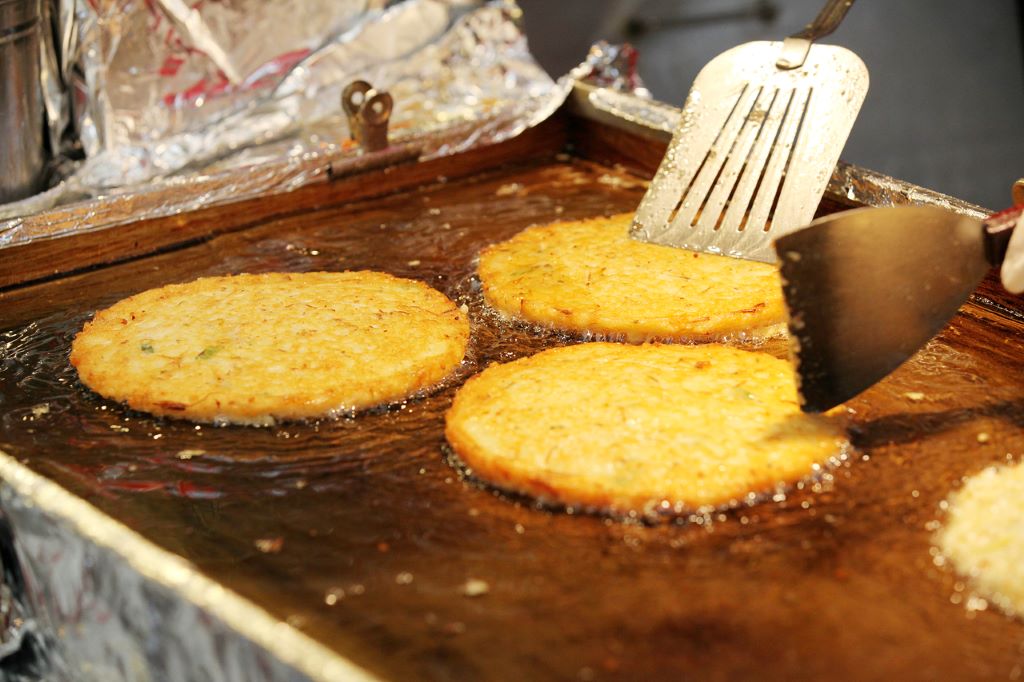
What is Bindaetteok?
“Bindaetteok” (빈대떡) is a popular Korean savory pancake made from mung beans. It’s also known as “mung bean pancake” or “mung bean sprout pancake.” It is a beloved street food and snack in Korea, enjoyed for its crispy texture, rich flavor, and the combination of ingredients that go into its batter.
Key Features of Bindaetteok:
- Mung Bean Base: It is primarily made from ground mung beans, which are soaked, ground into a batter, and then mixed with various ingredients.
- Ingredients: The batter of bindaetteok typically includes mung beans, mung bean sprouts, green onions, kimchi, and sometimes minced pork or seafood. These ingredients add flavor, texture, and color to the pancake.
- Crispy Exterior: When cooked, bindaetteok develops a crispy and golden-brown exterior, while the interior remains soft and flavorful.
- Dipping Sauce: It is often served with a dipping sauce made from soy sauce, vinegar, and other seasonings. The sauce complements the pancake’s flavors.

bindaetteok2 ⓒ한국관광공사 사진갤러리-한국관광공사 김지호 Bindaetteok recipe
- Soak Mung Beans: Mung beans are soaked in water for a few hours or overnight to soften them.
- Grind Mung Beans: The soaked mung beans are ground into a coarse batter. Some variations include adding a bit of water to achieve the right consistency.
- Mix Ingredients: Chopped mung bean sprouts, green onions, kimchi, and any other desired ingredients are mixed into the batter.
- Cook Pancakes: The batter is spooned onto a hot oiled griddle or pan, forming individual pancakes. The pancakes are flattened slightly with a spatula.
- Fry Until Crispy: The bindaetteok is cooked over medium heat until the bottom is golden and crispy. It’s then flipped to cook the other side until crispy as well.
- Serve: It is cut into wedges and served with a dipping sauce, often made from soy sauce, vinegar, sesame oil, and possibly other seasonings.
Variations:
- Yachae Bindaetteok: This is a vegetarian version of bindaetteok that omits the meat and seafood, making it suitable for vegetarians.
- Nokdu Bindaetteok: “Nokdu” means mung beans in Korean, so this variation simply refers to the classic mung bean pancake.
- Seafood Bindaetteok: Some versions of bindaetteok include seafood, such as shrimp or squid, in addition to mung bean sprouts and other ingredients.
It is often enjoyed as a snack, appetizer, or side dish in Korean cuisine. Its unique combination of ingredients and textures, along with its satisfying crunch, make it a popular choice among locals and visitors alike.
History of Bindaetteok
It has a long history in Korean cuisine, with its origins dating back to the Joseon Dynasty (1392–1897). The dish has evolved over time and is now a beloved street food and comfort food enjoyed by many in Korea. Here’s a brief overview of the history of bindaetteok:
Joseon Dynasty Influence: The roots of bindaetteok can be traced back to the Joseon Dynasty, where it was initially known as “bindaejeon.” During this period, mung beans were used to create simple and nutritious pancakes. The dish was considered a practical way to make use of available ingredients, including mung beans and various vegetables.
Becoming a Street Food: As Korea’s culinary culture evolved, It transitioned from being a home-cooked dish to a popular street food. It was particularly popular in the bustling markets and busy streets of Korea. Vendors would set up makeshift stalls and cook It on griddles over open flames, attracting hungry customers with its enticing aroma.
Ingredients and Variations: Bindaetteok was traditionally made with mung beans and other simple ingredients like green onions, garlic, and seasoning. As the dish gained popularity and spread across different regions of Korea, variations emerged. Some regions added specific local ingredients to the batter, resulting in unique regional styles of bindaetteok.
Modern Adaptations: Over time, bindaetteok continued to evolve. In the modern era, the dish is often made with a mixture of mung beans, mung bean sprouts, vegetables, and sometimes meat or seafood. The ingredients are ground into a batter, then fried until crispy on the outside and soft on the inside.
Cultural Significance: Bindaetteok has a special place in Korean culture as a beloved comfort food. It’s a dish that many Koreans have fond memories of enjoying with family and friends, whether as a street food snack or a homemade treat. It’s often associated with festive occasions, picnics, and gatherings.
Global Popularity: In recent years, bindaetteok’s popularity has extended beyond Korea’s borders, as Korean cuisine gains international recognition. Korean restaurants in various parts of the world now offer bindaetteok as a flavorful and unique dish that showcases the culinary heritage of Korea.
Overall, bindaetteok’s history reflects its transformation from a simple mung bean pancake to a cherished part of Korea’s culinary tradition. Its journey from the Joseon Dynasty to modern-day street food stalls and restaurants is a testament to its enduring appeal and cultural significance.
How to eat Bindaetteok?
Eating bindaetteok, the savory Korean mung bean pancake, is a simple and enjoyable experience. The crispy texture on the outside and the flavorful ingredients on the inside make it a popular street food and snack. Here’s how to eat bindaetteok:
- Cut into Wedges: Bindaetteok is typically served as a large pancake that is cut into smaller wedges for easier eating and sharing. It’s often presented on a plate or in a serving dish.
- Dipping Sauce: Before you start eating, you can prepare a dipping sauce. A common dipping sauce for bindaetteok is a mixture of soy sauce, vinegar, sesame oil, and possibly a touch of red pepper flakes. This dipping sauce adds extra flavor to each bite.
- Dip and Enjoy: Take a wedge of bindaetteok and dip it into the dipping sauce. Make sure to coat the pancake with a bit of the sauce to enhance its flavor.
- Bite and Savor: Take a bite of the bindaetteok, savoring the crispy exterior and the soft, flavorful interior. The combination of textures and flavors is what makes bindaetteok so satisfying.
- Optional Additions: Some people like to add additional ingredients to their bindaetteok wrap. For example, you can add fresh lettuce leaves, perilla leaves (kkaennip), or other leafy greens to create a wrap around the pancake.
- Create a Wrap (Optional): If you’re adding lettuce or perilla leaves, place a leaf on your palm, add a piece of bindaetteok, and fold the leaf around the pancake. This creates a small wrap that holds the ingredients together.
- Additional Garnishes (Optional): Some restaurants may provide additional garnishes like sliced green onions, garlic, or kimchi to further enhance the flavors.
- Repeat and Share: Continue to enjoy the bindaetteok wedges, dipping each bite into the sauce as desired. It’s a dish meant to be shared and enjoyed with others, so feel free to have a fun and social eating experience.
Remember that part of the appeal of bindaetteok is the contrast between the crispy exterior and the soft interior, as well as the combination of flavors from the mung beans, vegetables, and any meat or seafood included. Enjoy it at your own pace, and feel free to customize each bite to your taste by adjusting the amount of dipping sauce and any additional ingredients you choose to include.
Where is Gwangjang si jang?
Gwangjang Market (광장시장) is a well-known traditional market located in Seoul, South Korea. It’s one of the oldest and largest markets in the city, offering a wide range of goods, including clothing, textiles, kitchenware, and, most famously, street food and traditional Korean dishes. The market’s history dates back to 1905, and it has been a bustling hub of commerce and culture ever since.
Location: Gwangjang Market is situated in the Jongno-gu district of Seoul, which is known for its historical and cultural significance. The exact address of Gwangjang Market is 88 Changgyeonggung-ro, Jongno-gu, Seoul.
Highlights of Gwangjang Market:
- Street Food: Gwangjang Market is renowned for its diverse and delicious street food offerings. Visitors can enjoy various Korean snacks and dishes such as bindaetteok (mung bean pancakes), mayak gimbap (miniature seaweed rice rolls), tteokbokki (spicy rice cakes), and more.
- Traditional Market Stalls: The market is lined with countless stalls selling clothing, textiles, fabrics, hanbok (traditional Korean clothing), bedding, and other goods.
- Silk Alley: Gwangjang Market is famous for its Silk Alley, where you can find a wide array of silk and satin fabrics that can be purchased by the meter.
- Dried Seafood and Ingredients: The market offers a variety of dried seafood, spices, grains, and other ingredients used in Korean cuisine.
- Bindaetteok Stalls: Some of the most popular and historic stalls within the market specialize in bindaetteok. These stalls have been serving the mung bean pancakes for generations and are a must-visit for those looking to experience authentic Korean street food.
- Dongdaemun Design Plaza: Gwangjang Market is located near the Dongdaemun Design Plaza (DDP), a futuristic architectural landmark that hosts various cultural events, exhibitions, and shopping opportunities.
Gwangjang Market offers an immersive and authentic experience of Korean culture and cuisine. Whether you’re looking to shop for traditional goods, sample delicious street food, or explore the bustling atmosphere of a traditional market, Gwangjang Market is a place you won’t want to miss during your visit to Seoul.
Recommend to Read >>Jokbal, Korean cuisine made with pig’s trotters Aug, 2023.
-
Jjajangmyeon, Korean Black Noodle Aug, 2023.
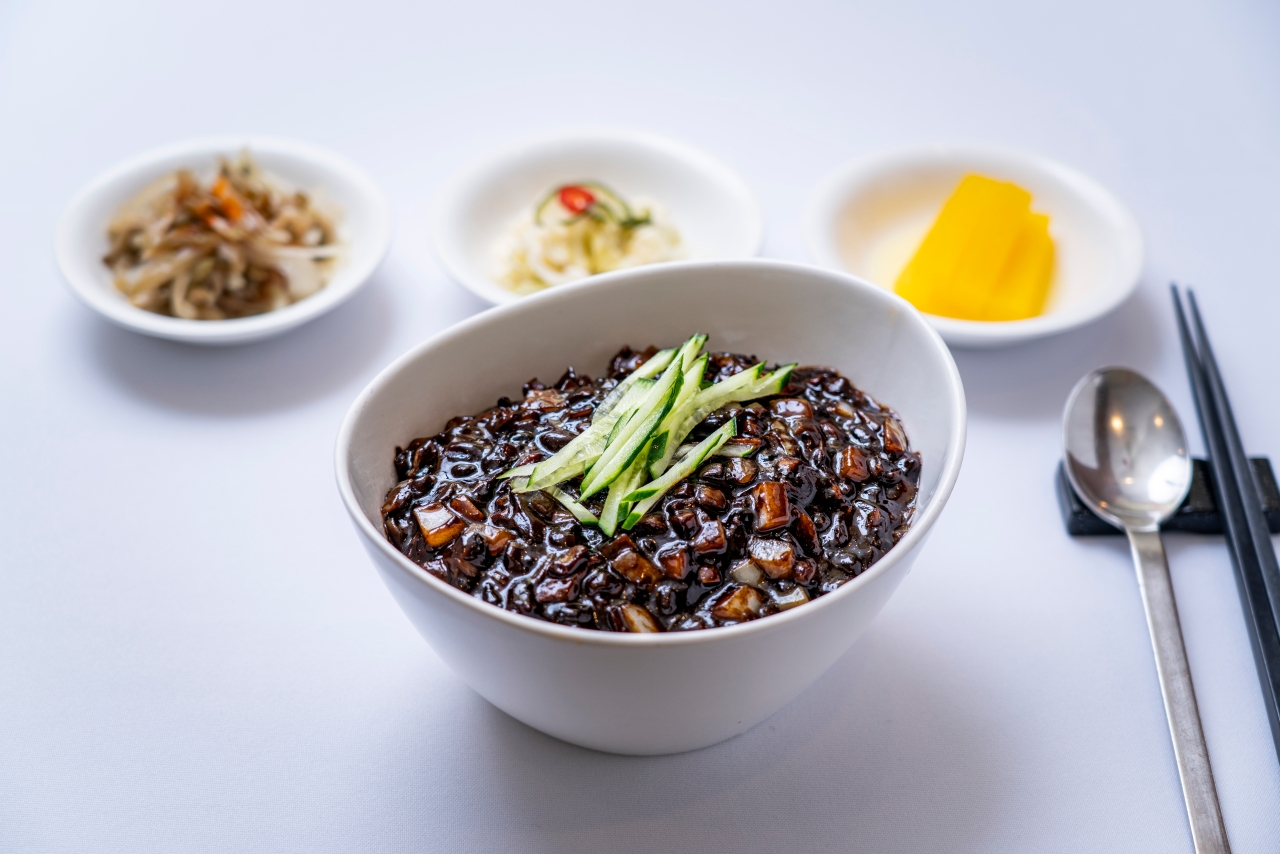
What is Jjajangmyeon?
Jjajangmyeon (짜장면) is a popular Korean-Chinese noodle dish that features a savory black bean sauce served over wheat noodles. It’s a comfort food enjoyed by many in South Korea and is often ordered from Chinese restaurants or delivered as takeout. The dish has a rich and satisfying flavor profile, making it a beloved choice for both casual meals and special occasions.
Key Characteristics of Jjajangmyeon:
- Black Bean Sauce: The defining feature of jjajangmyeon is its thick and glossy black bean sauce. This sauce is made from black bean paste (chunjang), which is created by fermenting soybeans and roasted wheat flour. It imparts a deep umami flavor to the dish.
- Wheat Noodles: The noodles used in jjajangmyeon are typically made from wheat flour. They are often chewy and have a pleasant texture that complements the sauce.
- Protein and Vegetables: Jjajangmyeon is often prepared with diced pork or other proteins like seafood. The dish is also loaded with diced vegetables such as onions, zucchini, and potatoes, which are sautéed in the black bean sauce.
- Comforting and Hearty: The combination of the savory black bean sauce, tender meat, and vegetables over a bed of noodles creates a comforting and hearty dish that’s enjoyed by people of all ages.
Preparation and Serving: Jjajangmyeon is typically ordered from Chinese restaurants or takeaway joints, but it can also be made at home. To prepare jjajangmyeon:
- Cook the Noodles: Boil the wheat noodles according to the package instructions. Drain and set aside.
- Sauté the Ingredients: In a pan, sauté diced pork (or other protein) until cooked. Add diced vegetables and continue to sauté until they are tender.
- Add the Black Bean Sauce: Pour the black bean paste (chunjang) over the cooked ingredients. Stir well to coat the meat and vegetables in the sauce.
- Simmer: Add a bit of water or broth to achieve the desired consistency of the sauce. Let the mixture simmer for a few minutes, allowing the flavors to meld together.
- Serve: Serve the black bean mixture over the cooked noodles. Optionally, garnish with sliced cucumbers or pickled radish. Some variations also include a raw egg that you can mix into the hot sauce for added richness.
Variations and Sides: Jjajangmyeon can have variations like seafood jjajangmyeon, which includes seafood instead of pork. It’s often served with tangsuyuk (sweet and sour pork) or other Chinese-style side dishes.
Jjajangmyeon is a comfort food with a unique fusion of Chinese and Korean flavors, and it’s a dish that has become an integral part of Korean cuisine and culinary culture.
Which country’s food is jajangmyeon? Chinese or Korean?
The history of jjajangmyeon is a tale of culinary adaptation and cultural fusion. While the dish has its origins in China, it has been embraced and transformed into a beloved Korean comfort food. Here’s an overview of the history of jjajangmyeon:
Chinese Origins: The original dish, known as “zhajiangmian” (炸酱面) in Mandarin Chinese, can be traced back to the Shandong province of China. Zhajiangmian consists of wheat noodles topped with a savory sauce made from ground pork or soybean paste, fermented soybean paste, and various seasonings. This Chinese dish was brought to Korea by Chinese immigrants, particularly during the late 19th and early 20th centuries.
Introduction to Korea: As Chinese immigrants settled in Korea, they brought their culinary traditions with them, including the concept of black bean noodles. However, the Korean adaptation began to take shape as local ingredients and preferences influenced the dish’s evolution.
Adaptation to Korean Tastes: Koreans adapted the original zhajiangmian to suit their own palate and available ingredients. The Korean version, jjajangmyeon, features a thick and glossy black bean sauce made from chunjang, a type of fermented black bean paste. This sauce is sautéed with various ingredients, including diced pork, vegetables, and sometimes seafood. The resulting dish has a unique balance of flavors that reflects Korean culinary sensibilities.
Popularization in Korea: Jjajangmyeon gained popularity in Korea over the years, becoming a comfort food enjoyed by people of all ages. It became especially popular during challenging times, including the post-Korean War era, as it was an affordable and filling meal. The dish’s hearty and satisfying qualities contributed to its enduring popularity.
Cultural Significance: Jjajangmyeon holds cultural significance in Korea and is often associated with celebrations and special occasions. It’s a popular choice for birthdays, and it’s even considered a traditional meal for those who move into new homes.
Modern Jjajangmyeon: Today, jjajangmyeon is commonly found in Korean-Chinese restaurants, takeout joints, and delivery services. It’s a staple of Korean cuisine, and various adaptations and regional variations exist throughout South Korea.
The history of jjajangmyeon is a testament to the dynamic nature of food culture, where culinary influences can transcend borders and be embraced in new and creative ways. While the dish’s origins lie in China, its transformation into a beloved Korean dish reflects the ongoing exchange and evolution of culinary traditions.
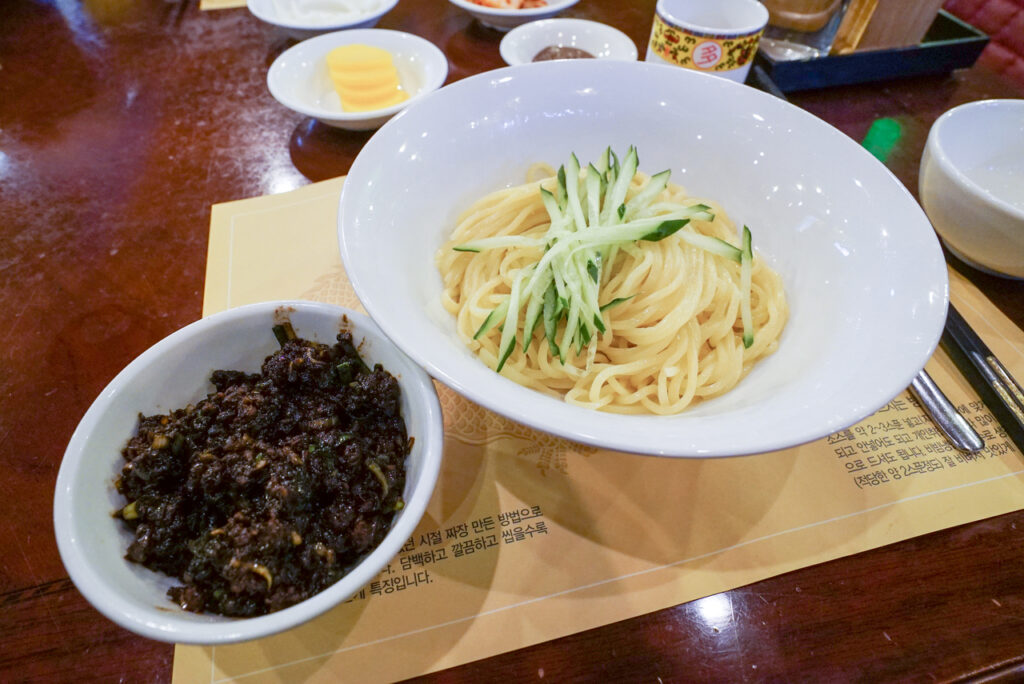
Jjajangmyeon2 ⓒ한국관광공사 사진갤러리-한국관광공사 김지호 Jjajangmyeon in China town, Korea
Yes, you can find jjajangmyeon in Chinatown in Incheon city, South Korea. Incheon’s Chinatown, known as “Incheon Chinatown” or “Incheon Jung-gu Chinatown,” is a popular tourist destination that offers a variety of Chinese and Korean-Chinese dishes, including jjajangmyeon. The area is known for its vibrant atmosphere, cultural attractions, and diverse dining options.
Incheon Chinatown is one of the few remaining traditional Chinatowns in South Korea and is characterized by its colorful buildings, traditional architecture, and bustling streets. Visitors to Incheon Chinatown can explore a range of Chinese and Korean-Chinese eateries that serve dishes influenced by Chinese cuisine, as well as local adaptations that cater to Korean tastes.
Jjajangmyeon is one of the iconic dishes you can enjoy in Incheon Chinatown. Many restaurants in the area offer authentic jjajangmyeon, which features the rich and savory black bean sauce served over wheat noodles. This dish is typically served with various side dishes and is a popular choice among both locals and tourists.
In addition to jjajangmyeon, you’ll likely find other Chinese-inspired dishes, such as jajangbap (rice topped with black bean sauce), tangsuyuk (sweet and sour pork), and more. Exploring Incheon Chinatown provides an opportunity to indulge in the fusion of Chinese and Korean culinary traditions.
If you’re a fan of jjajangmyeon or interested in exploring the unique dining experiences offered in Incheon Chinatown, consider visiting this vibrant neighborhood to enjoy a taste of both Chinese and Korean-Chinese cuisine.
Chinese Restaurant in Korea.
Chinese restaurants in Korea offer a diverse range of dishes that are influenced by Chinese culinary traditions but are often adapted to suit Korean tastes. These restaurants serve a variety of dishes that include noodles, rice dishes, dim sum, and more. Here are some common types of food you can expect to find at Chinese restaurants in Korea:
- Jjajangmyeon: This Korean-Chinese dish features wheat noodles topped with a savory black bean sauce. It’s one of the most popular dishes at Chinese restaurants in Korea.
- Tangsuyuk: Sweet and sour pork is a deep-fried dish that features crispy battered pork pieces coated in a sweet and tangy sauce.
- Jjamppong: This is a spicy seafood noodle soup that features a rich and spicy broth with various seafood ingredients and vegetables.
- Bokkeumbap: Chinese-style fried rice often includes a mix of vegetables, meat, and sometimes seafood, all stir-fried with rice and seasonings.
- Mapo Tofu: A spicy and flavorful dish made with tofu cubes cooked in a spicy sauce with minced meat, chili bean paste, and Sichuan peppercorns.
- Hot Pot (Sujeo-gui): Chinese-style hot pot dishes involve cooking an assortment of raw ingredients, such as meat, seafood, vegetables, and noodles, in a simmering broth at the table.
- Dim Sum: Some Chinese restaurants offer dim sum, which are small, flavorful dishes served in steamer baskets or small plates. They include dumplings, buns, spring rolls, and more.
- Spring Rolls: Fried or fresh spring rolls filled with various combinations of vegetables, meat, and sometimes seafood.
- Jajangbap: Similar to jjajangmyeon, this dish features a savory black bean sauce served over rice instead of noodles.
- Fried Noodles (Chow Mein): Stir-fried noodles with vegetables, meat, and sometimes seafood, cooked in various sauces.
- Sweet and Sour Dishes: Apart from tangsuyuk, other sweet and sour dishes are available, featuring a variety of proteins and vegetables.
- Dumplings (Mandu): Chinese-style dumplings can include various fillings, such as pork, vegetables, and kimchi.
- Sichuan Dishes: Some Chinese restaurants specialize in Sichuan cuisine, offering dishes with bold and spicy flavors, such as Kung Pao chicken or Sichuan-style stir-fries.
- Congee (Juk): A rice porridge dish often served with various toppings and condiments.
- Desserts: Some Chinese restaurants offer sweet treats like sesame balls, red bean paste-filled pastries, and more.
Chinese restaurants in Korea often adapt these dishes to cater to local preferences and may offer a mix of traditional Chinese flavors and Korean twists. Keep in mind that the menus can vary from restaurant to restaurant, and there are different regional Chinese cuisines represented as well.
Recommend to Read >> Budae Jjigae, food with the pain of Korean War 1950.
-
Jokbal, Korean cuisine made with pig’s trotters Aug, 2023.
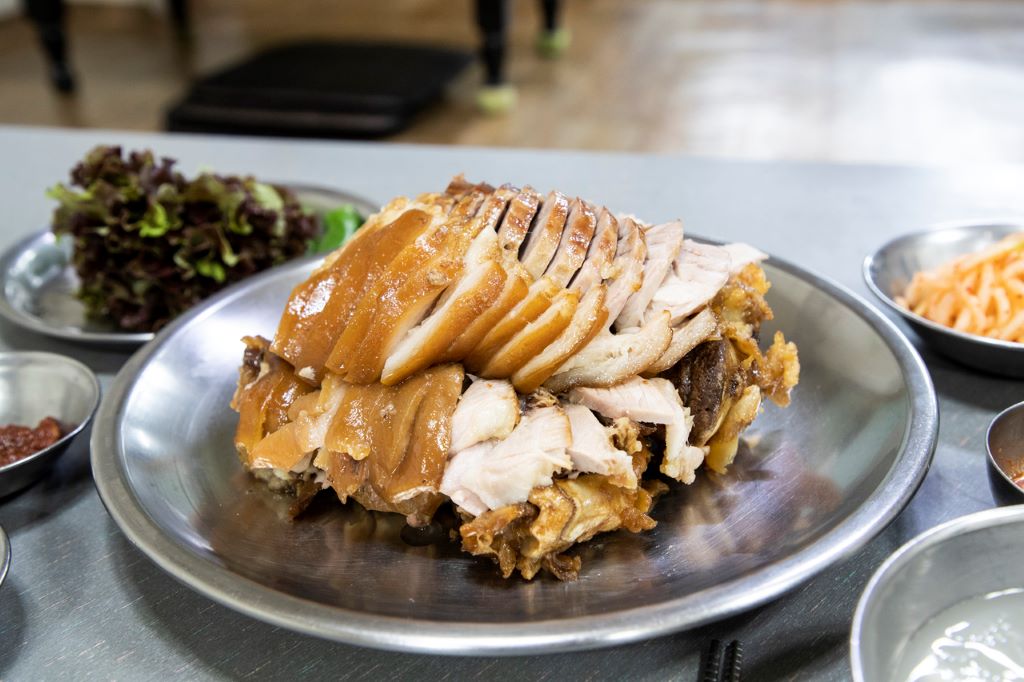
What’s a Jokbal?
Jokbal (족발):
Jokbal is a popular Korean dish made from pig’s trotters that are seasoned, braised, and then sliced before being served. This dish has a rich history that dates back several centuries, reflecting the influence of both Korean culinary traditions and Chinese cuisine.Chinese Influence:
The origins of It can be traced back to the Chinese dish “zhǔjiǎo” (猪脚), which also features braised pig’s trotters. During the Goryeo Dynasty (918-1392) in Korea, Chinese culinary influences began to make their way into Korean cuisine, and It is believed to be a result of this cultural exchange.Transformation in Korea:
While It was influenced by the Chinese dish, Koreans adapted it to suit their own taste preferences and ingredients. The process of making it involves thoroughly cleaning the pig’s trotters and then simmering them in a flavorful broth with various seasonings, including soy sauce, garlic, ginger, and aromatic spices. This slow-cooking process results in tender, flavorful meat that is both savory and slightly sweet.Historical Significance:
In Korea, this has been enjoyed for centuries and has been associated with festive occasions and celebrations. It was considered a special dish often enjoyed during holidays, birthdays, and other significant events.Popularization and Modern Era:
Over time, It became more widely available and accessible to the general population. Street vendors and restaurants began to offer jokbal as a popular dish, both for special occasions and everyday consumption. One’s popularity continued to grow, and it became a beloved comfort food enjoyed by people of all ages.Variations and Accompaniments:
While the traditional jokbal is braised and served as sliced meat, there are variations that include seasoned or spicy versions. In addition, It is often accompanied by side dishes such as pickled vegetables, kimchi, and garlic.Cultural Significance:
It’s enduring popularity speaks to its cultural significance in Korean cuisine. It represents a harmonious blend of traditional Korean flavors and Chinese culinary influences, showcasing how different cultures can come together to create a beloved dish that stands the test of time.Today, it remains a popular dish in Korea, enjoyed by locals and visitors alike. It’s a dish that reflects both the history and evolution of Korean cuisine, making it an integral part of the country’s culinary heritage.
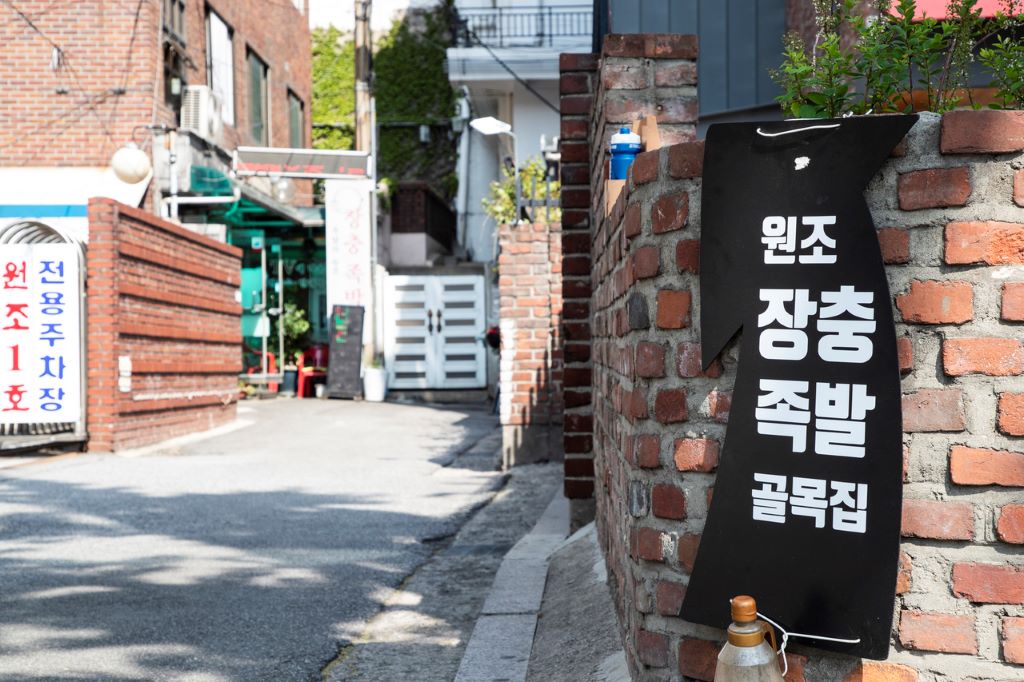
jokbal street – ⓒ한국관광공사 사진갤러리-한국관광공사 이범수 Jokbal Golmok in Jangchung Dong in Seoul
Jangchung Jokbal Golmok, also known as Jangchung-Dong Jokbal Street, is a renowned food street in Seoul, South Korea, famous for its specialized restaurants and vendors that serve one, the beloved Korean dish made from braised pig’s trotters. This street is located in the Jangchung-dong neighborhood, near the Dongdaemun area. Here’s more about the famous Jangchung Jokbal Golmok:
Overview:
Jangchung Jokbal Golmok is a culinary destination that attracts locals and tourists alike who are looking to enjoy high-quality and flavorful one. The street is lined with numerous it’s restaurants and eateries, each with its unique preparation methods, seasonings, and accompanying side dishes.Highlights:
Variety of Choices: Jangchung Jokbal Golmok offers a diverse range of it’s options, from classic preparations to modern twists and variations. Visitors can choose from a selection of restaurants based on their preferences for flavor, texture, and ambiance.
Atmosphere:
The street has a vibrant and bustling atmosphere, especially during peak dining times. The scent of braised pig’s trotters fills the air, creating an inviting ambiance that draws people in.
Side Dishes: In addition to the that itself, many restaurants along Jangchung Jokbal Golmok offer an array of side dishes and accompaniments that enhance the overall dining experience. These side dishes often include pickled vegetables, kimchi, radish, and more.
Cultural Experience: Exploring Jangchung Jokbal Golmok is not only a culinary experience but also a cultural one. It’s an opportunity to immerse oneself in Korean food culture, witness local dining customs, and engage with a beloved dish that holds a special place in Korean cuisine.
Famous Restaurants:
While many establishments along Jangchung Jokbal Golmok are popular, a few restaurants have gained particular recognition for their jokbal offerings. One well-known restaurant in the area is “Jangchung-Dong Jokbal,” which has been praised for its delicious and authentic jokbal dishes.Visiting Jangchung Jokbal Golmok:
If you’re a fan of jokbal or interested in experiencing this iconic Korean dish, Jangchung Jokbal Golmok is a must-visit destination. It’s a chance to explore the rich flavors, culinary traditions, and vibrant food scene of Seoul. Whether you’re a local seeking comfort food or a traveler looking to savor a unique culinary adventure, Jangchung Jokbal Golmok is sure to offer a memorable experience.Hometown Food of North Korean Displaced People
After the Korean War broke out in 1950 and divided into North and South Korea, North Koreans who could not return to their hometowns, or ‘displaced people’, lived in Jangchung-dong.
Those who are home to Pyeongan-do and Hamgyeong-do began to make and eat pig’s feet, which are food for important events such as weddings, and as a large sports facility called Jangchung Gymnasium was built nearby, many events were held here, making local food famousCooking Method
Making jokbal, the popular Korean dish of braised pig’s trotters, requires time, patience, and attention to detail. Here’s a basic recipe to guide you through the process of making jokbal at home:
Ingredients:
2-3 pig’s trotters (cleaned and hair removed)
Water for blanching
1 onion, peeled and quartered
1 piece of ginger (about 2 inches), sliced
4-5 cloves of garlic, smashed
1/2 cup soy sauce
1/4 cup rice wine (or mirin)
1/4 cup brown sugar
1 teaspoon black peppercorns
1 cinnamon stick
2-3 star anise
Water, as needed
Optional: hard-boiled eggs, cooked chestnuts
Instructions:Blanch the Trotters:
Place the cleaned pig’s trotters in a large pot of boiling water.
Allow them to boil for about 10 minutes to remove excess impurities.
Drain and rinse the trotters thoroughly under cold water.
Prepare the Broth:In a large pot, combine the blanched trotters, onion, ginger, garlic, soy sauce, rice wine, brown sugar, black peppercorns, cinnamon stick, and star anise.
Add enough water to cover the trotters.
Braise the Trotters:Bring the mixture to a boil, then reduce the heat to a simmer.
Cover the pot and let the trotters simmer for 2-3 hours, or until the meat is tender and easily separates from the bone.
Check the water level occasionally to ensure the trotters are submerged. Add more water if needed.
Cool and Slice:Once the trotters are tender, remove them from the broth and let them cool slightly.
While the trotters are still warm, use a sharp knife to carefully slice the meat into bite-sized pieces.
Serve:Arrange the sliced jokbal on a serving plate.
If desired, you can also include hard-boiled eggs and cooked chestnuts as accompaniments.
Optionally, you can reduce the broth until it thickens slightly to create a dipping sauce.
Enjoy:Jokbal is often served with various side dishes, such as pickled vegetables and kimchi.
Dip the jokbal pieces into the dipping sauce or enjoy them as they are.
Note: Making jokbal requires time and patience, as the trotters need to be braised until they are tender and flavorful. The choice of seasonings and the braising time can vary based on personal preference and regional variations.Keep in mind that making jokbal at home may be a more elaborate process compared to other dishes, but the end result is a delicious and satisfying Korean delicacy that’s worth the effort.
Recommend to Read >>> 2023 Korean Andong Jjimdak Recipe
-
Naengmyeon, Chilled Delight: Exploring the Cool Delicacy of it Aug 2023.
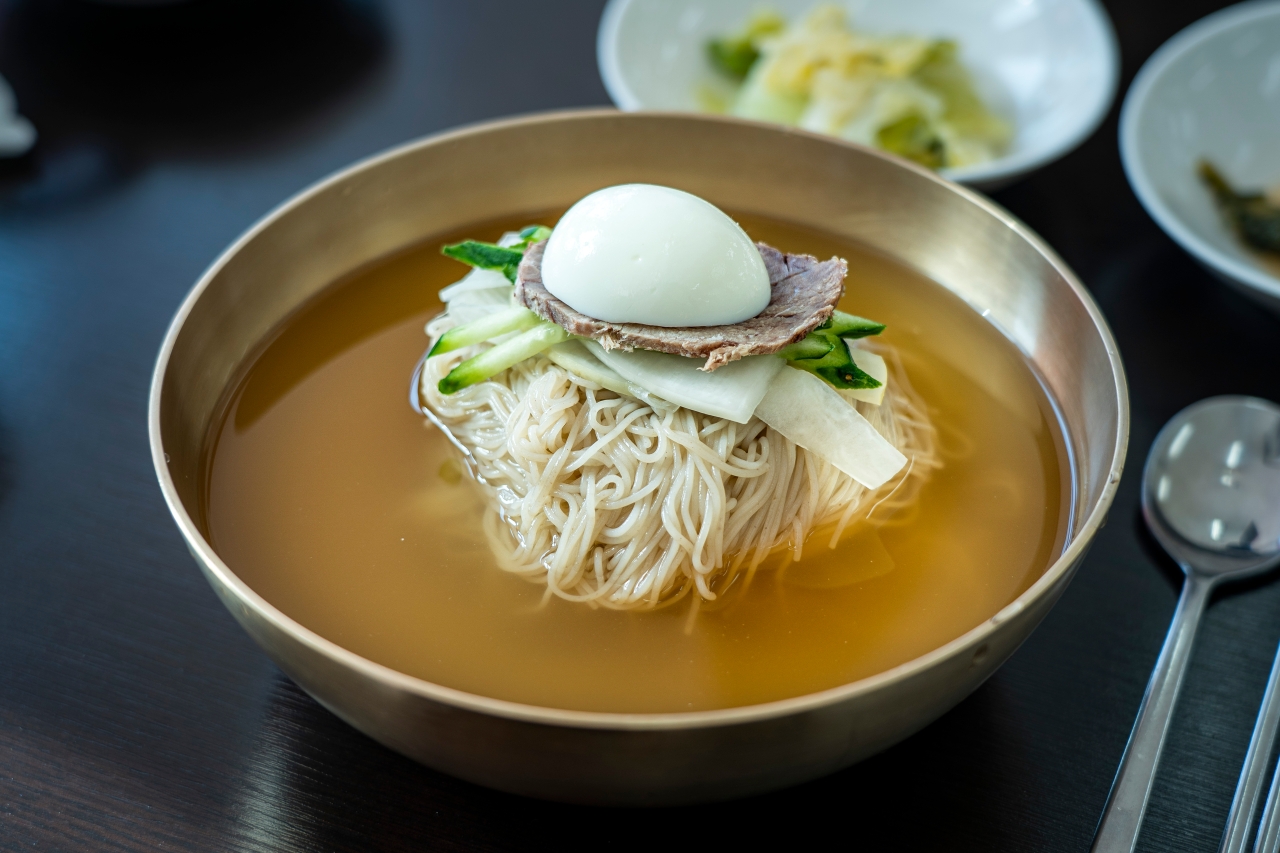
Naengmyeon, Indulge in the Refreshing Flavor of Korean Cold Noodles
When the sun blazes high and temperatures soar, there’s nothing quite like the cool embrace of naengmyeon, Korea’s beloved chilled noodle dish. With its origins dating back centuries, it has evolved into a tantalizing culinary masterpiece that captures the essence of Korean cuisine.
A Tradition of Cool Comfort : It’s story unfolds against the backdrop of Korean history. Its roots can be traced to the Joseon Dynasty, where creativity met necessity to create a satisfying summer delight. The dish’s transformation continued through the Japanese colonial period and the post-war era, resulting in the flavorful variations we savor today.
From Pyongyang to Hamheung:As diverse as the regions from which they hail, Pyongyang naengmyeon and Hamheung naengmyeon bring unique twists to the table. Pyongyang naengmyeon offers a mild, slightly sweet broth, while Hamheung naengmyeon tantalizes the palate with its tangy flavors derived from water kimchi.
The Art of Assembly:Whether you opt for mul naengmyeon’s delicate interplay of cold noodles and clear broth or indulge in bibim naengmyeon’s fiery dance of flavors, each bite is a symphony of taste and texture. Fresh vegetables, pickled radish, and the iconic hard-boiled egg enhance the visual appeal and culinary experience.
A Cultural Tradition: it isn’t just a dish; it’s a celebration of Korea’s cultural adaptability and culinary finesse. It’s a testament to the harmony between historical influences and local creativity, capturing the essence of each season and reflecting the ingenuity of a nation.
So, venture into the world —where tradition meets innovation, and coolness meets culinary delight. As you twirl those chilled noodles and savor the refreshing flavors, you’ll understand why it is not just a dish; it’s an experience—an edible oasis in the scorching heat of summer.
History of Naengmyeon
The history of it, or cold noodles, in Korean cuisine dates back several centuries and has evolved over time to become a beloved and iconic dish. The origins of it can be traced to the Korean peninsula’s historical interactions with China and its own culinary traditions. Here’s an overview of the history of naengmyeon:
1. Influences from China:
The concept of cold noodles is believed to have been introduced to Korea through cultural exchanges with China. Cold noodle dishes were already present in Chinese cuisine, and this culinary influence gradually made its way to Korea. The idea of serving chilled noodles was well-suited to Korea’s hot and humid summers, contributing to the popularity of the dish.
2. Development and Evolution:
IT began to take shape as a Korean dish during the Joseon Dynasty (1392-1897). At the time, noodles were made from ingredients like buckwheat and sweet potato starch. The Joseon court culture likely played a role in refining and popularizing naengmyeon.
3. Regional Variations:
Different regions of Korea developed their own variations of it, each with distinct characteristics:
- Pyongyang Naengmyeon: Originating from the capital city of North Korea, Pyongyang naengmyeon is known for its mild broth and slightly sweet flavor.
- Hamheung Naengmyeon: This variation comes from the city of Hamheung in North Korea and features a tangy and refreshing broth made with dongchimi, a type of water kimchi.
4. Japanese Colonial Period:
During the Japanese colonial rule over Korea (1910-1945), naengmyeon underwent some changes due to cultural influences. Buckwheat noodles from Japan were introduced to Korea, leading to the use of buckwheat noodles in naengmyeon dishes.
5. Post-Korean War Period:
After the Korean War, Korea experienced a period of economic recovery and rebuilding. It became a popular and affordable dish, providing a cooling and satisfying option during hot summers.
6. Modern Era:
It continued to evolve in the post-war period with variations like mul naengmyeon (served in cold broth) and bibim naengmyeon (mixed with spicy sauce). Restaurants specializing in it became more prevalent, and the dish gained a place in popular culture as a quintessential summer food.
Today, it remains a cherished dish in Korean cuisine, enjoyed by locals and visitors alike. It reflects the culinary creativity and adaptability of Korean culture over the centuries, while also serving as a refreshing and comforting option during hot weather.
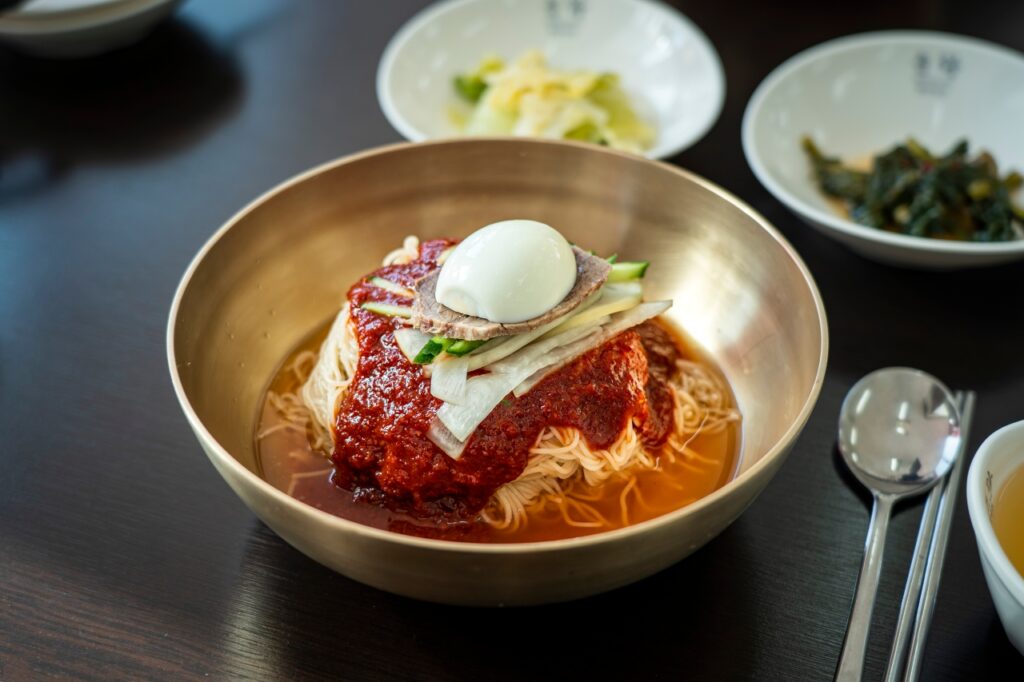
ⓒ한국관광공사 사진갤러리-살롱드베이커 How to enjoy Naengmyeon?
Eating naengmyeon is a delightful experience that involves savoring the refreshing and flavorful combination of cold noodles, broth (in mul naengmyeon), and various toppings. Here’s a step-by-step guide on how to enjoy them:
1. Get Comfortable: Find a comfortable seat and get ready to enjoy yours. Since it is a cold dish, it’s particularly popular during hot weather to help cool you down.
2. Mix the Sauce (for Bibim Naengmyeon): If you’re enjoying bibim naengmyeon (the spicy sauce version), start by thoroughly mixing the sauce. This ensures that the gochujang (red chili paste) and other seasonings are evenly distributed throughout the noodles.
3. Slurp and Savor: Using chopsticks and a long spoon, begin to take bites of the chilled noodles. Slurping the noodles is a common practice in Korean cuisine, as it’s believed to enhance the overall flavor experience. The chewy texture of the noodles combined with the cold temperature provides a unique sensation.
4. Enjoy the Broth (for Mul Naengmyeon): If you’re enjoying mul naengmyeon (the cold broth version), start by taking sips of the clear and refreshing broth. The mild and slightly seasoned broth complements the noodles and toppings.
5. Explore the Toppings: It is typically garnished with various toppings that add both flavor and texture to the dish. Explore the different toppings, such as thinly sliced cucumbers, radish, Korean pear, and sometimes a hard-boiled egg. These toppings provide a balance of freshness and crunch.
6. Mix and Match: Feel free to mix and match the toppings with the noodles and broth/sauce as you go along. Each bite can be customized to your taste preferences, creating a dynamic and enjoyable eating experience.
7. Enjoy the Refreshment: As you continue to enjoy your naengmyeon, you’ll experience the cooling and refreshing qualities of the dish. The combination of cold ingredients, flavors, and textures makes naengmyeon a unique and satisfying culinary experience.
8. Savor Until the Last Bite: Continue enjoying yours at your own pace until you’ve savored every last bite. Don’t hesitate to slurp the noodles, savor the broth, and appreciate the interplay of flavors.
9. Finish with Satisfaction: Once you’ve finished yours, you can lean back with satisfaction, relishing the unique flavors and the sense of refreshment that the dish offers.
Remember, it is not just a meal; it’s an experience. Whether you’re enjoying it with friends, family, or on your own, take your time and savor the cool and flavorful journey that this iconic Korean dish provides.
Good things to enjoy with Naengmyeon.
This is a versatile dish that can be enjoyed on its own or paired with a variety of side dishes and accompaniments. Here are some good things to enjoy with naengmyeon to enhance your culinary experience:
1. Kimchi: Kimchi is a staple in Korean cuisine and pairs wonderfully with naengmyeon. The spicy, tangy, and fermented flavors of kimchi complement the cool and refreshing nature of the dish.
2. Pickled Radish: Sweet and tangy pickled radish is a common side dish that provides a refreshing contrast to the cold noodles. Its crunchiness adds texture to your meal.
3. Korean Pancakes (Jeon): Savory Korean pancakes, known as “jeon,” come in various flavors like kimchi, seafood, or vegetable. Their diverse flavors and textures make them a great accompaniment to naengmyeon.
4. Mandu (Dumplings): Mandu, Korean dumplings, are another excellent choice to enjoy with that. They can be steamed or pan-fried and provide a satisfying contrast to the noodles.
5. Bindaetteok: Bindaetteok, or mung bean pancakes, are crispy and savory pancakes made from ground mung beans and vegetables. They’re a delightful side dish that pairs well with naengmyeon.
6. Japchae: Japchae, a Korean stir-fried noodle dish, offers a different noodle texture compared to naengmyeon. The mix of vegetables and flavors in japchae can complement the naengmyeon’s simplicity.
7. Tangy Dipping Sauces: Tangy dipping sauces, such as soy sauce with vinegar and sesame oil, can be used to enhance the flavors of the noodles and toppings.
8. Hard-Boiled Egg: Adding a sliced hard-boiled egg to yours not only offers a protein boost but also adds creaminess and flavor.
9. Fresh Fruit: Slices of fresh Korean pear or watermelon can provide a juicy and sweet contrast to the cold noodles.
10. Cold Beverage: Pair your naengmyeon with a cold drink like water, iced tea, or a traditional Korean fruit punch called “sikhye” for a well-rounded meal.
11. Side Vegetables: Served alongside naengmyeon, blanched or seasoned vegetables like spinach, bean sprouts, and seaweed can provide additional flavors and textures.
12. Fish Cake: Korean fish cakes, or “eomuk,” are often served as a side dish and can add a slightly savory and chewy element to your experience.
Ultimately, the choice of accompaniments depends on your personal preferences and the flavors you enjoy. Experiment with different combinations to discover your favorite pairings that enhance the overall enjoyment of your meal.
Recommend to Read >> Doenjang, Korean soul sauce Aug, 2023.
-
Budae Jjigae, food with the pain of Korean War 1950.
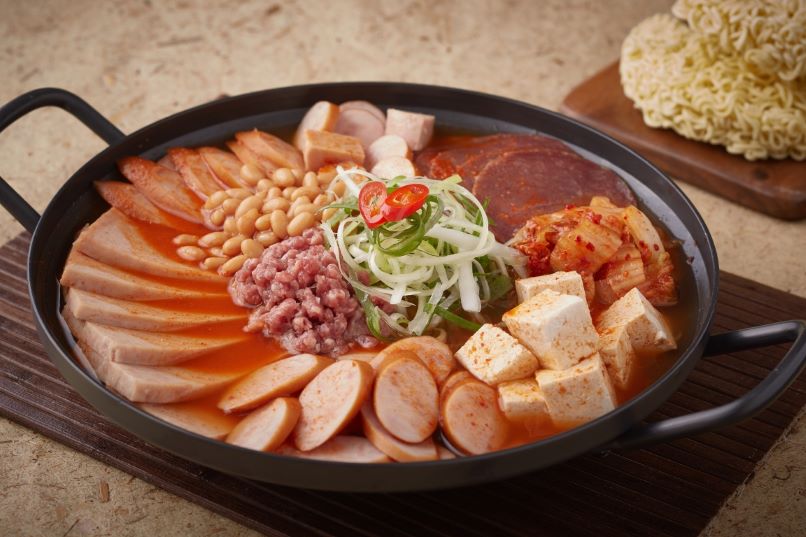
History of Bujae Jjigae
Budae jjigae, also known as “Army Stew,” has a fascinating history that is closely tied to the socio-economic and cultural context of post-Korean War South Korea. The dish’s creation reflects a blend of necessity, resourcefulness, and the blending of culinary influences. Here’s a brief overview of the history of budae jjigae:
Post-Korean War Scarcity: The Korean War (1950-1953) left South Korea devastated, both economically and socially. Food scarcity was a significant challenge, and people had to find ways to make do with limited resources. During this period, food rations and surplus items from U.S. military bases played a role in shaping the creation of it.
Origin of the Name: The term “budae” (부대) translates to “army base” in Korean, and “jjigae” (찌개) means “stew.” The name “budae jjigae” reflects the dish’s origins, as it was created using ingredients that were commonly found near U.S. military bases.
Creation and Influences: As the story goes, Koreans started using surplus processed meats, such as spam, sausages, and hot dogs, which were abundant in American military rations. These meats were combined with Korean ingredients like kimchi, tofu, vegetables, and instant noodles to create a hearty and flavorful stew. The combination of Korean and American influences led to the unique fusion nature of it.
Shared Nostalgia: Over time, this evolved from being a necessity-driven dish to a popular comfort food that holds a sense of nostalgia for many Koreans. It became a symbol of resilience and adaptability in the face of challenging circumstances.
Cultural Significance: It is not only a culinary creation but also a cultural artifact that reflects the post-war history and the enduring spirit of the Korean people. It showcases how food can adapt to circumstances and become a part of the cultural fabric.
Modern Variations: Today, it is enjoyed by people of all ages and backgrounds in South Korea. While the original version was born out of necessity, modern variations of the dish are available in restaurants and households across the country. Some contemporary versions feature higher-quality ingredients while still retaining the essence of the original dish.
In summary, budae jjigae’s history is rooted in the challenges of post-Korean War South Korea, where resourcefulness led to the creation of a unique and beloved dish that symbolizes both the past and the present.

Budae Jjigae street in Uijeongbu City Budae Jjigae related to the US Army
The names “Uijeongbu Budae Jjigae” and “Songtan Budae Jjigae” are both tied to specific locations in South Korea where the dishes originated. Let’s explore the reasons behind these names:
1. Uijeongbu Budae Jjigae: As previously mentioned, Uijeongbu Budae Jjigae refers to the regional variation of Budae jjigae (Army Stew) that originated in the city of Uijeongbu, located in Gyeonggi Province, South Korea. The name reflects the dish’s connection to the city. “Uijeongbu” (의정부) is the name of the city where this version of Jjigae was created.
The historical significance of Uijeongbu in the creation and popularization of it led to the association of the dish’s name with the city. The term “Uijeongbu Budae Jjigae” signifies that this particular variation of them originates from Uijeongbu and carries the culinary and cultural history of the region.
2. Songtan Budae Jjigae: Similarly, “Songtan Budae Jjigae” refers to a regional variation of Budae jjigae that has its origins in the town of Songtan, located near Osan Air Base in Pyeongtaek, Gyeonggi Province, South Korea. Songtan is another area that has a historical connection to the U.S. military presence in South Korea.
The name “Songtan Budae Jjigae” is derived from the name of the town, “Songtan” (송탄), where this variation of the dish was likely popularized due to its proximity to the U.S. military base. The name reflects the dish’s origin and the cultural context of its creation.
Culinary Identity and Heritage: Both “Uijeongbu Budae Jjigae” and “Songtan Budae Jjigae” highlight the historical and cultural significance of these regional variations of Budae jjigae. These names help distinguish these specific versions from the broader category of Budae jjigae and emphasize their unique connections to their respective locations. The names not only indicate the dish’s place of origin but also contribute to the culinary identity and heritage of these regions.
Cooking Method
Ingredients: It typically includes a wide variety of ingredients, resulting in a diverse and flavorful dish. Common ingredients found in the stew include:
- Processed meats: Sausages, spam, hot dogs, ham, and bacon.
- Canned goods: Baked beans, canned chili, and canned vegetables.
- Korean elements: Kimchi, tofu, vegetables, instant ramen noodles, and sliced rice cakes.
- Broth: The stew is often cooked in a spicy broth made with gochugaru (red pepper flakes) and other seasonings.
Preparation: It is typically prepared in a large communal pot. The ingredients are simmered together in the spicy broth until everything is cooked and the flavors meld together. The resulting stew is rich, spicy, and satisfying, with a combination of flavors and textures.
Serving: It is commonly enjoyed as a shared dish among friends and family. It’s often accompanied by a variety of banchan (side dishes) and served with rice. The communal nature of the dish makes it a popular choice for group gatherings and social occasions.
Modern Variations: While the original budae jjigae was created out of necessity and resourcefulness, modern versions of the dish often include a mix of both traditional and modern ingredients. Some restaurants even offer gourmet versions with higher-quality meats and ingredients.
Budae jjigae reflects a unique aspect of Korean culinary history and culture, showcasing how creativity and resourcefulness can lead to the creation of a beloved and distinctive dish.
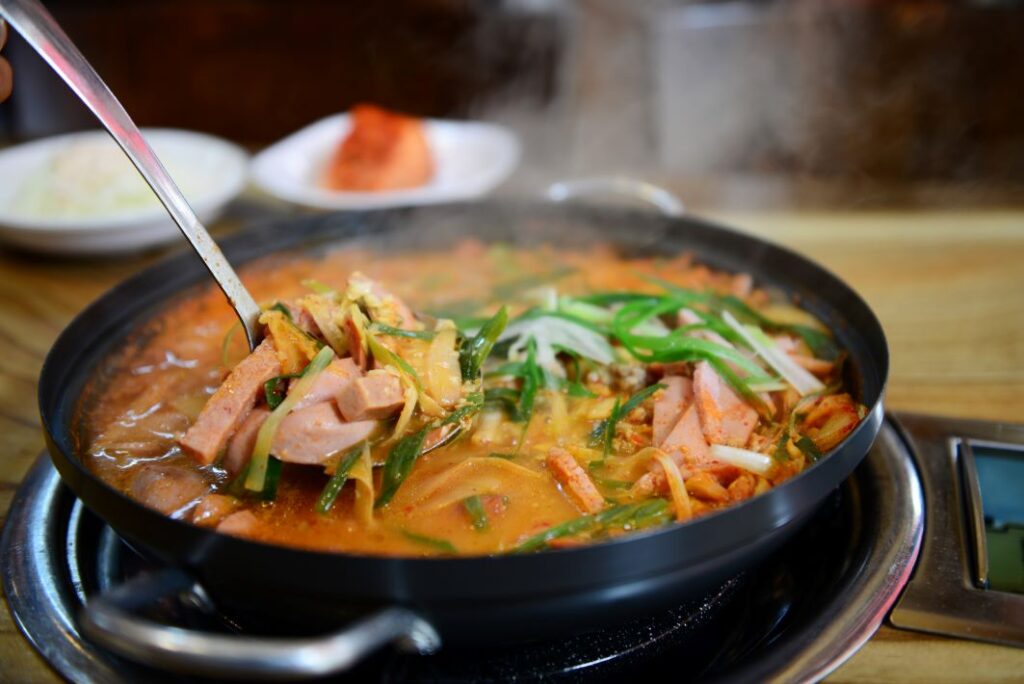
Budae Jjigae -ⓒ한국관광공사 사진갤러리-IR 스튜디오 Recommend to Read >> Gimbap: 9 Reasons Koreans Like It
-
Doenjang, Korean soul sauce Aug, 2023.
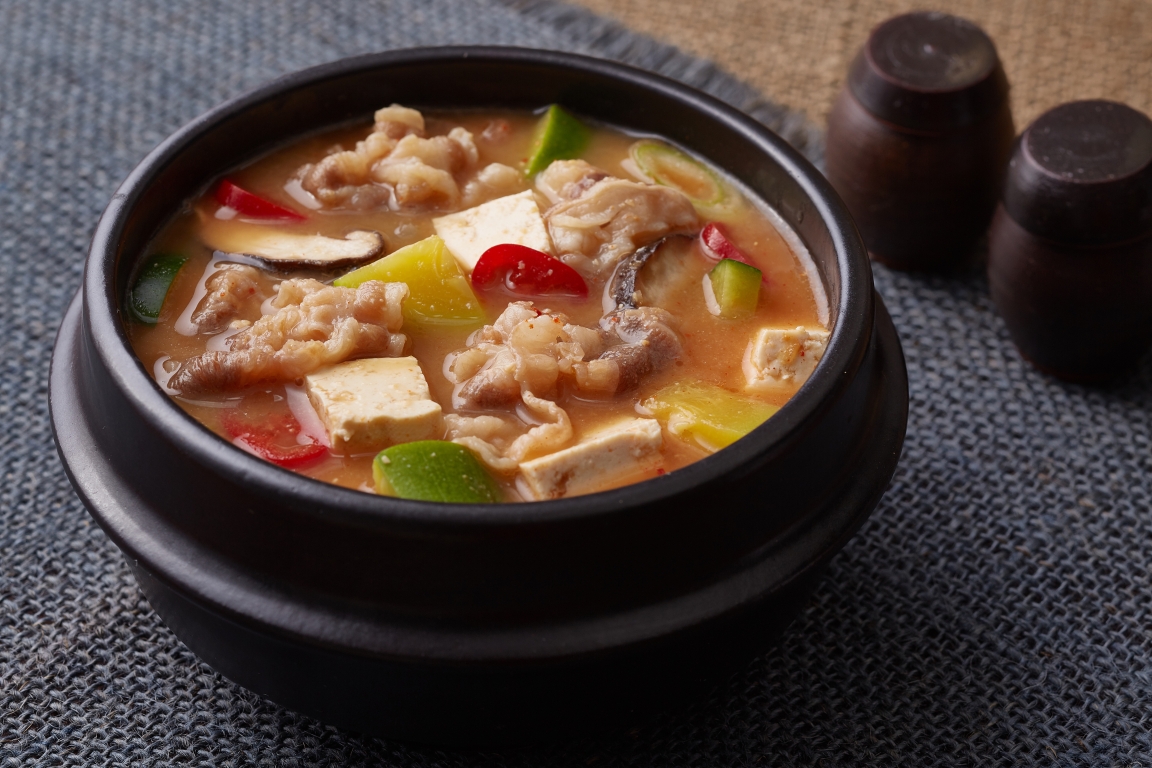
What is Doenjang?
Doenjang (된장) is a traditional Korean fermented soybean paste that plays a central role in Korean cuisine. It’s a versatile and essential ingredient used in various dishes to add depth of flavor and umami.
It has a long history in Korean culinary traditions and is a fundamental component of many Korean dishes. Here’s more about doenjang:
Ingredients and Fermentation: It is made by fermenting soybeans, often along with other grains like barley or rice, with the help of a specific type of mold called Aspergillus oryzae. The fermentation process can take several months to develop the rich flavors and complex aromas that characterize doenjang.
Varieties and Types: There are different varieties one, which can vary in taste, color, and consistency based on factors such as the ingredients used, the duration of fermentation, and regional preferences. Some common types of doenjang include:
- Regular : This is the most common type of doenjang and is typically used as a base for soups, stews, and sauces.
- Mild : Some varieties are milder in flavor, which can be suitable for those who prefer a less intense taste.
- Soybean-Rice : This type is made by fermenting a mixture of soybeans and rice. It has a slightly sweeter flavor and lighter color.
Uses in Cooking: it is a fundamental ingredient in Korean cuisine, and its uses are diverse:
- Soups and Stews: It is often used as a base for Korean soups and stews, such as doenjang jjigae (fermented soybean paste stew) and tteokguk (rice cake soup).
- Sauces: It’s used to make ssamjang (a dipping sauce for wraps), dipping sauces for vegetables, and marinades for grilled meats.
- Flavor Enhancer: It adds depth and complexity to a wide range of dishes, enriching the overall flavor profile.
- Side Dishes: It’s also used to make banchan (side dishes), such as doenjang banchan, which are small dishes served alongside rice.
- Noodles: Doenjang-based sauces are used as toppings for various noodle dishes.
Health Benefits: It is not only flavorful but also nutritious. It’s a source of protein, fiber, and essential amino acids. Additionally, it contains probiotics that are beneficial for gut health.
Cultural Significance: It holds cultural significance as a staple in Korean kitchens. It’s considered a fundamental ingredient that connects modern generations to the culinary traditions of their ancestors.
What is difference between Deonjang and Miso?
Doenjang and miso are both fermented soybean pastes used in Asian cuisines, but they originate from different cultures and have distinct flavors and characteristics. Here are the key differences between doenjang and miso:
Origin and Culture:
- Doenjang: It is a traditional Korean fermented soybean paste. It has been a staple of Korean cuisine for centuries and plays a fundamental role in many Korean dishes.
- Miso: Miso is a Japanese fermented soybean paste that is an integral part of Japanese cuisine. It has a long history in Japanese culinary traditions and is used in a variety of Japanese dishes.
Ingredients and Fermentation:
- Doenjang: It is made by fermenting soybeans, often with other grains like barley or rice, using a specific type of mold called Aspergillus oryzae. The fermentation process takes several months to develop the desired flavors.
- Miso: Miso is also made from fermented soybeans, along with grains like rice or barley. The fermentation process involves different strains of mold, depending on the type of miso being produced. The duration of fermentation varies and can result in different flavors and colors.
Flavor and Taste:
- Doenjang: It has a robust, savory, and deep flavor profile with a rich umami taste. It has a complex aroma and can range from slightly salty to more intense, depending on the type and duration of fermentation.
- Miso: Miso has a range of flavors, from sweet and mild to salty and intense, depending on the type of miso. Generally, white miso (shiro miso) is milder and slightly sweet, while red miso (aka miso) is stronger and saltier.
Color and Texture:
- Doenjang: It is typically darker in color, ranging from brown to dark reddish-brown. It has a thick and hearty texture.
- Miso: Miso varies in color, from light beige (white miso) to deep reddish-brown (red miso). The texture can also vary, with white miso being smoother and softer, while red miso is denser.
Culinary Uses:
- Doenjang: It is a fundamental ingredient in Korean cuisine. It’s used to make soups, stews, sauces, marinades, and side dishes, contributing to the savory and umami flavors of the dishes.
- Miso: Miso is a versatile ingredient in Japanese cuisine. It’s used to make miso soup, dressings, marinades, glazes, and more. Miso also plays a significant role in traditional Japanese dishes like miso ramen.
What is Meju?

Meju – ⓒ한국관광공사 사진갤러리- 한국관광공사 김지호 Meju (메주):Meju is a term in Korean cuisine that refers to fermented soybean blocks or bricks. It is a key ingredient in the production of various Korean fermented foods, such as doenjang (fermented soybean paste) and ganjang (soy sauce). Meju serves as the starting point for the fermentation process, as it provides the foundation of flavors and enzymes that develop over time.
The process of making meju involves cooking and fermenting soybeans.The basic steps are as follows:
Soaking: Soybeans are soaked in water to rehydrate them.Boiling: The soaked soybeans are boiled until they become soft and plump.
Mashing: The cooked soybeans are mashed or ground into a paste-like consistency.
Shaping: The mashed soybeans are shaped into rectangular blocks or bricks.
Fermentation: The meju blocks are left to ferment in a controlled environment. During fermentation, natural microorganisms, including molds and bacteria, develop on the surface of the blocks. These microorganisms play a crucial role in breaking down the soybeans and creating the complex flavors of the final products, such as doenjang and ganjang.
Drying: After fermentation, the meju blocks are typically sun-dried or air-dried to reduce moisture content and stabilize the fermentation process.
Meju serves as a basis for creating various fermented foods in Korean cuisine:
Doenjang: Meju blocks are used to make doenjang, the traditional fermented soybean paste. The meju blocks are combined with salt and other ingredients and allowed to ferment further, resulting in the rich and savory doenjang paste.
Ganjang: Meju blocks can also be used to produce ganjang, the traditional soy sauce. The blocks are soaked in brine, and the resulting liquid is then aged to develop the flavor of soy sauce.
Chungkukjang: As mentioned earlier, meju blocks are used to make chungkukjang, another type of fermented soybean paste with a distinct pungent flavor.
Meju is an essential ingredient in Korean fermentation traditions, contributing to the unique flavors and characteristics of various fermented foods. The process of making meju requires skill and experience, and it is an important part of preserving Korean culinary heritage.What is Ganjang and Chungkukjang?
Ganjang (간장): Ganjang is a traditional Korean soy sauce that is widely used as a seasoning and flavoring agent in Korean cuisine. It’s a fundamental ingredient that adds depth of flavor and umami to various dishes. Ganjang is made through a fermentation process involving soybeans, water, salt, and a specific type of mold known as Aspergillus oryzae. The mixture is left to ferment and age, resulting in the development of rich and complex flavors.
There are different types of ganjang, including:
- Joseon Ganjang: Also known as traditional soy sauce, this type of ganjang is aged for a longer period and has a deep and robust flavor.
- Guk Ganjang: This is a lighter and milder soy sauce that is often used for making soups and broths.
- Jin Ganjang: Jin ganjang is a type of premium soy sauce made with high-quality ingredients. It has a more delicate and refined flavor.
Ganjang is used as a seasoning in various Korean dishes, including soups, stews, marinades, dipping sauces, and stir-fries. It’s an essential ingredient in Korean cooking, contributing to the umami and savory notes that are characteristic of Korean cuisine.
Chungkukjang (청국장): Chungkukjang is a type of fermented soybean paste that shares similarities with doenjang but is produced through a different fermentation process. While doenjang is made with the addition of specific molds and fermented grains, chungkukjang is typically made with just soybeans and water. The fermentation process of chungkukjang results in a strong and distinct flavor, often described as pungent and intense.
Chungkukjang is known for its potent aroma and deep umami taste. It’s often used as a base for soups, stews, and sauces, particularly in Korean temple cuisine. Due to its strong flavor, chungkukjang is used in smaller quantities compared to other soybean pastes like doenjang.
Both ganjang and chungkukjang are essential components of Korean cuisine, contributing to the complexity of flavors and the overall taste profile of a wide range of dishes.
What kinds of Korean Food?
Doenjang, the traditional Korean fermented soybean paste, is a versatile and essential ingredient used in a wide range of Korean dishes. Its rich umami flavor and depth contribute to the complexity of flavors in these dishes. Here are some popular foods that are made using doenjang:
- Doenjang Jjigae (된장찌개): Doenjang jjigae is a classic Korean stew made with It as the base. It often includes tofu, vegetables, mushrooms, and sometimes seafood or meat. That imparts a rich and savory flavor to the stew.
- Ssamjang (쌈장): Ssamjang is a dipping sauce made with It, gochujang (red chili paste), garlic, sesame oil, and other seasonings. It’s commonly used as a condiment for wraps (ssam) made with lettuce or other greens.
- Guk (된장국): Doenjang guk is a simple soup made by dissolving doenjang in water to create a flavorful broth. It’s often served with rice and side dishes.
- Banchan: It can be used as a seasoning or flavoring agent for various side dishes (banchan). For example, blanched vegetables can be coated with a doenjang-based sauce.
- Fried Rice: It can be used to season fried rice, adding a rich and savory taste to the dish.
- Marinated Meat: Doenjang can be used as a marinade for various proteins like beef, pork, or chicken. The marinade imparts a deep, savory flavor to the meat.
- Noodles: Doenjang-based broths can be used to create flavorful noodle dishes, such as doenjang ramen or noodles.
- Stew with Seafood (Haemul Doenjang Jjigae): This variation of doenjang jjigae includes a mix of seafood like shrimp, clams, and squid, adding a seafood dimension to the dish.
- Grilled Vegetables: Doenjang can be used as a glaze or marinade for grilled vegetables, enhancing their flavor.
- Doenjang Sauce for Bibimbap: Doenjang can be mixed with other ingredients to create a flavorful sauce for bibimbap, a popular Korean mixed rice dish.
- Doenjang-based Dipping Sauce: Doenjang can be combined with vinegar, sesame oil, and other seasonings to create a dipping sauce for vegetables, dumplings, or meats.
These are just a few examples of the many dishes and foods that incorporate doenjang as a central ingredient. Its versatile and savory nature makes it a key component of Korean cuisine, adding depth and richness to a variety of culinary creations.
Place for Doenjang Jjigae in Korea.
Munchulrae Doenjang 3-6, Jungang-daero214beon-Gil, Busan South Korea
Recommend to Read >> Makgeolli, the Harmony of Korean Food and Liquor – 2023
-
2023 Korean Andong Jjimdak Recipe
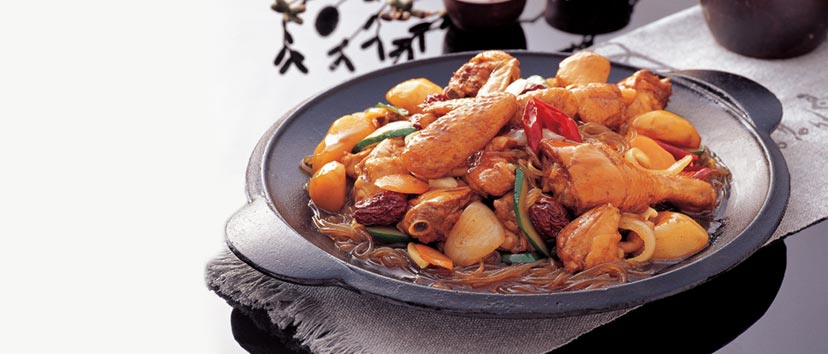
Do you know Jjimdak?
“Jjimdak” (찜닭) is a popular Korean dish that consists of braised chicken and various vegetables cooked in a flavorful and slightly spicy sauce. The name “jjim” refers to the braising cooking method, and “dak” means chicken in Korean. Jjimdak is known for its tender and succulent chicken pieces, along with the savory and slightly sweet taste of the sauce.
Here’s more about Jjimdak:
Jjimdak Recipe
Ingredients:
The main components of Jjimdak include:Chicken: Typically bone-in chicken pieces, often a combination of white and dark meat.
Vegetables: Common vegetables used include potatoes, carrots, onions, and sweet potatoes.
Sauce: The sauce for Jijmdak is made from a mixture of soy sauce, sugar, garlic, ginger, sesame oil, and Korean chili paste (gochujang). It’s a balance of savory, slightly sweet, and spicy flavors.
Preparation and Cooking:
Here’s how It is typically prepared:Preparation: The chicken pieces are usually cut into smaller portions, and the vegetables are also cut into bite-sized pieces. This allows for even cooking and better absorption of the flavors.
Sautéing: The chicken and vegetables are briefly sautéed in a pot or a wide pan to develop some color on the exterior.
Sauce and Braising: The sauce mixture is added to the pot, along with some water. The dish is then braised over medium heat, allowing the chicken and vegetables to absorb the flavors of the sauce.
Simmering: The pot is covered, and the dish simmers until the chicken becomes tender and the vegetables are cooked through. This slow cooking process allows the flavors to meld together.
Serving: Once cooked, It is served in the pot it was cooked in. It’s often garnished with chopped green onions and sesame seeds. Some variations also include chewy sweet potato noodles (dangmyeon) added to the dish.
Variations:
While the classic version of this features chicken and vegetables, there are also variations that incorporate other ingredients like mushrooms, seafood, or additional seasonings for different flavor profiles.Serving and Accompaniments:
It is commonly enjoyed as a shared dish in a group setting. It’s often served with a side of rice to balance the flavors and provide a filling meal. The sauce-soaked vegetables and tender chicken are flavorful and satisfying, making it a popular choice in Korean restaurants.Overall, this is a comforting and hearty dish that combines the comforting flavors of braised chicken with the richness of the sauce and the textures of the vegetables.
Jjimdak famous place in south Korea
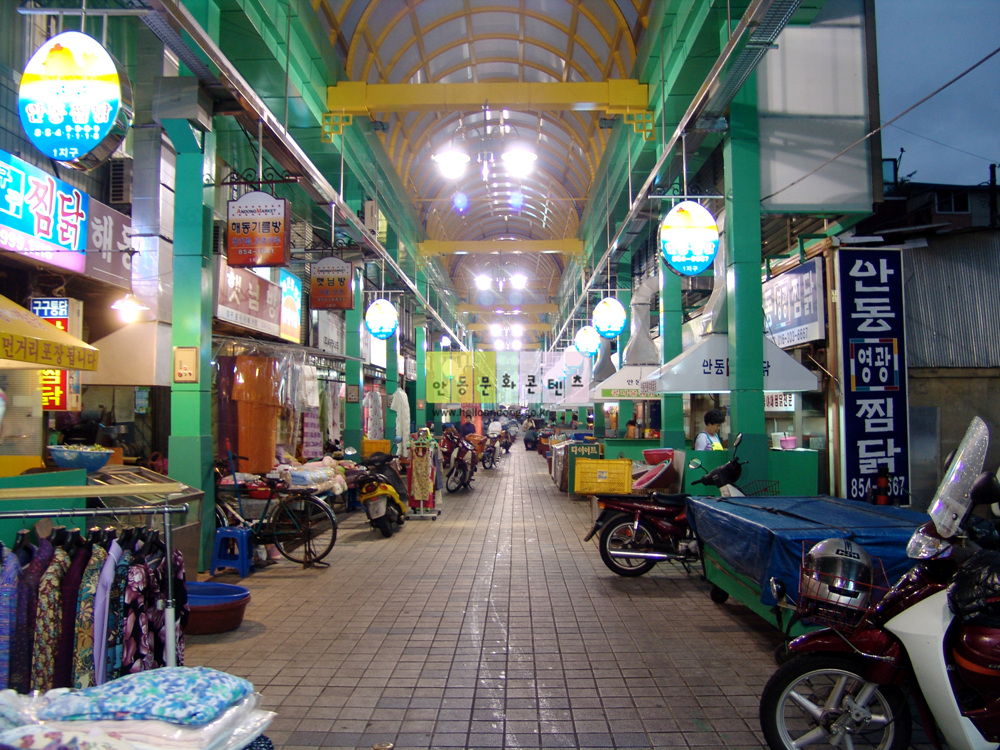
안동生 photo | 안동生 | 안동문화컨텐츠 (andong.go.kr) This is a popular Korean dish that can be found in various regions throughout South Korea. However, there are certain areas that are particularly well-known for their delicious and unique variations of Jjimdak. Here are a few places in South Korea that are famous for their Jjimdak:
Andong (안동): Andong-Jjimdak is one of the most famous regional variations of the dish. Andong is a city in Gyeongsangbuk-do Province known for its rich culinary heritage. Andong-Jjimdak is characterized by its slightly sweet and savory sauce, along with a combination of chicken, various vegetables, and glass noodles (dangmyeon). It’s a must-try dish if you’re in the Andong area.
Cheonan (천안): Cheonan, located in South Chungcheong Province, is another city known for its Jjimdak. Cheonan Jjimdak is often referred to as “chijeu Jjimdak,” where “chijeu” means “cheese” in Korean. This variation includes cheese as a topping, adding a creamy and indulgent element to the dish.
Seoul: As the capital city of South Korea, Seoul offers a wide variety of options from different regions. You can find restaurants and eateries that serve both traditional and modern variations. Some areas in Seoul, like the neighborhood of Sindang-dong, are particularly famous for their Jjimdak offerings.
Busan: Busan, a coastal city, has its own take on it with a seafood twist. Busan Jjimdak often includes ingredients like squid, shrimp, and mussels, in addition to chicken and vegetables. The seafood adds a unique flavor profile to the dish.
Incheon: Incheon, another major city in South Korea, has its own style of Jjimdak that is worth trying. Incheon-Jjimdak may have a milder flavor compared to other variations, appealing to those who prefer less-spicy dishes.
These are just a few examples of places where Jjimdak is famous in South Korea. Each region may have its own interpretation of the dish, incorporating local flavors and ingredients. If you’re traveling through South Korea, be sure to explore these regional variations of Jjimdak to experience the diversity of Korean cuisine.
Spicy chicken dish
Jjimdak, a Korean braised chicken dish, is not traditionally very spicy. The primary flavor profile of Jjimdak is savory and slightly sweet, with the potential to have a hint of spiciness depending on the recipe and personal preferences. While there are variations of Jjimdak that include spicy elements, the dish as a whole is not inherently known for its spiciness.
The primary factors that contribute to the spiciness of a particular dish include:
Gochugaru (Korean Red Pepper Flakes): Some recipes may include a small amount of gochugaru, which is Korean red pepper flakes. Gochugaru is commonly used in Korean cuisine to add heat and flavor to dishes. Depending on the quantity used, it can introduce a mild to moderate level of spiciness.
Gochujang (Korean Red Pepper Paste): Gochujang is another staple in Korean cooking and is made from fermented soybeans and red pepper. It can be used to add depth of flavor and a subtle spiciness to Jjimdak.
Personal Preferences: Some people enjoy adding extra gochugaru or gochujang to their Jjimdak to make it spicier. This is a matter of personal taste, and the level of spiciness can be adjusted according to individual preferences.
Regional Variations: As with many Korean dishes, there can be regional variations of Jjimdak that differ in flavor and spice levels. Some regions might have a preference for spicier Jjimdak, while others may emphasize other flavor elements.
It’s important to note that the majority of Jjimdak recipes do not include high levels of spiciness, and many versions of the dish focus more on the balance between savory, sweet, and umami flavors. If you prefer a less spicy version of Jjimdak, you can look for recipes that use minimal or no gochugaru or gochujang, or you can adjust the spice levels according to your taste.
What is similar food with Jjimdak in the world?
Jjimdak, the Korean braised chicken dish, shares some similarities with dishes from various cuisines around the world. While the exact combination of flavors and ingredients may differ, the concept of slow-cooking meat with vegetables and flavorful sauces is a common culinary practice in many cultures. Here are a few dishes that share similarities with Jjimdak:
Chicken Cacciatore (Italy): Chicken Cacciatore is an Italian dish that involves braising chicken in a tomato-based sauce with onions, bell peppers, mushrooms, and herbs. The slow-cooking process allows the flavors to meld together, resulting in a rich and comforting dish.
Coq au Vin (France): Coq au Vin is a classic French dish in which chicken is braised with red wine, mushrooms, onions, and bacon. The long cooking time allows the chicken to become tender and absorb the flavors of the wine and other ingredients.
Adobo (Philippines): Filipino Adobo is a dish where meat, often chicken, is marinated and braised in a mixture of vinegar, soy sauce, garlic, and other spices. The braising process infuses the meat with a savory and slightly tangy flavor.
Tajine (Morocco): Tajine is a North African dish cooked in a special clay pot of the same name. The dish typically includes meat, such as chicken, along with vegetables, dried fruits, and a blend of aromatic spices. It’s slow-cooked to create tender and flavorful results.
Hainanese Chicken Rice (Singapore/Malaysia): While not a braised dish, Hainanese Chicken Rice involves poaching chicken in a flavorful broth and serving it with fragrant rice and various condiments. The focus on tender chicken and complementary flavors is reminiscent of Jjimdak.
Rendang (Indonesia/Malaysia): Rendang is a slow-cooked dish originating from Indonesia and Malaysia. It involves simmering meat, often beef, in a mixture of coconut milk and spices until the liquid is reduced and the meat becomes tender. The dish is deeply flavorful and aromatic.
Shawarma (Middle East): While not braised, shawarma involves marinating and slow-cooking meat on a vertical rotisserie. The cooked meat is shaved off and often served in flatbreads with vegetables and sauces, creating a savory and hearty meal.
While these dishes may not be identical to Jjimdak, they showcase the global appeal of slow-cooked meats combined with flavorful sauces and complementary ingredients. Each dish reflects the culinary traditions and preferences of its respective region.

안동찜닭 | 안동음식&이야기 | 음식/문화 | 안동시 농업기술센터 (andong.go.kr) Andong-Jjimdak, Seoul Myeog-dong
Restaurant name : Andong-Jjimdak
Address : Myeong-dong 2ga, 2-2 Seoul South Korea
Tel : +82-02-310-9174
-
Hodugwaja, Korean No.1 walnut cake since 1934
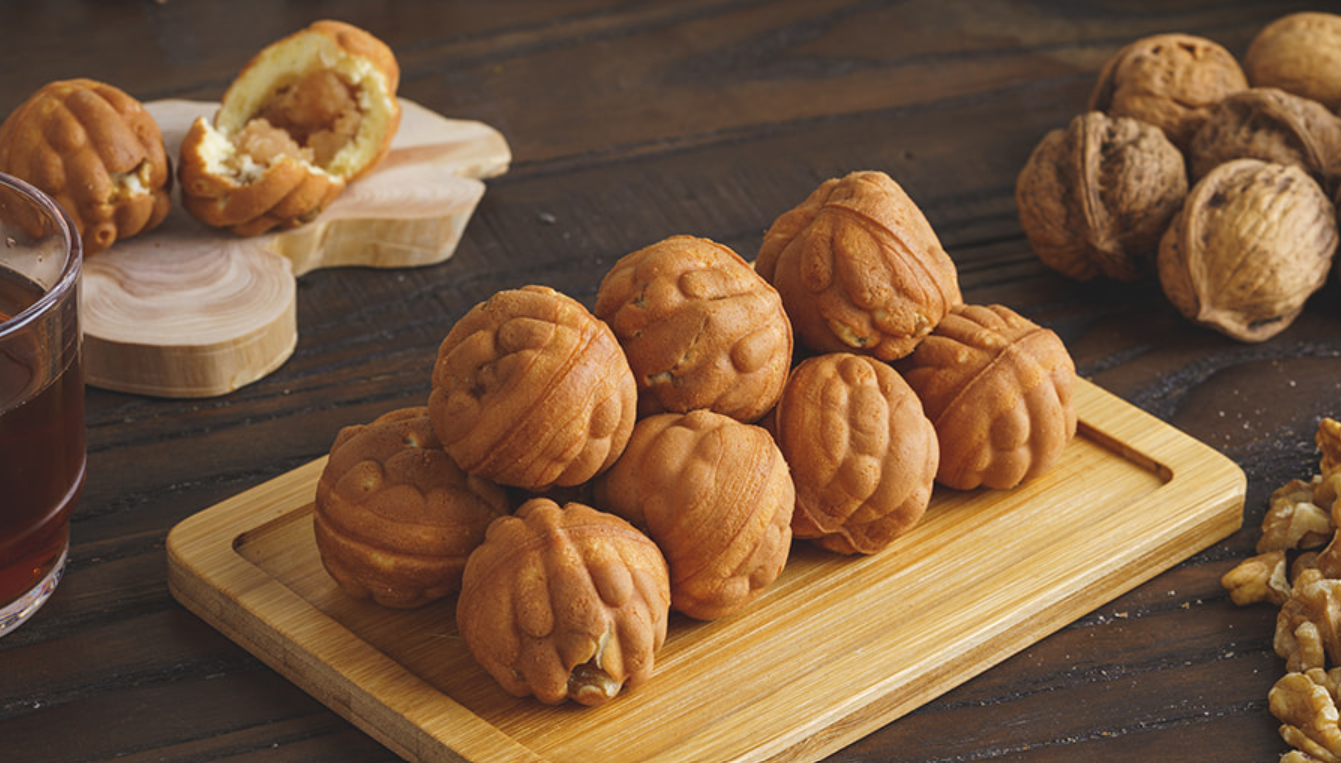
Hodugwaja is created in 1934
Hodugwaja (호두과자) is a popular Korean traditional pastry that originated in the city of Cheonan. It is known for its unique shape, delicious filling, and popularity as a street food and snack. The name “hodugwaja” translates to “walnut cake” in English, but the pastry itself doesn’t always contain walnuts. Instead, it’s named after its walnut-like appearance.
Here’s more about Hodugwaja:
Shape and Appearance: Hodugwaja is characterized by its distinctive walnut-shaped design. It consists of two halves that are joined together, forming a small, round, walnut-like shape. The pastry’s outer layer is made from a dough that’s pressed into a walnut mold. The halves are filled with a sweet and flavorful filling, which is a key element of the pastry.
Filling Varieties: While traditional hodugwaja fillings were often made from red bean paste, modern variations offer a range of fillings to cater to different tastes. Some common fillings include:
- Red Bean Paste (Patang, 팥앙): A classic filling that is slightly sweet and has a smooth texture.
- Walnut and Honey (Hodu Matang, 호두마탕): A popular filling made from crushed walnuts and honey, offering a nutty and slightly sticky texture.
- Cream Cheese and Sweet Potato (Cream Cheese Goguma, 크림치즈 고구마): A modern twist that combines cream cheese and sweet potato for a creamy and mildly sweet filling.
- Chocolate (Chokollit, 초콜릿): Some hodugwaja are filled with chocolate for a richer and indulgent flavor.
- Custard (Keoseuteo, 커스테오): Custard-filled hodugwaja offer a smooth and creamy texture with a hint of sweetness.
Preparation and Cooking: The dough for hodugwaja is made from a mixture of flour, water, sugar, and other ingredients. The dough is placed into the walnut-shaped mold, then a spoonful of filling is added to one half. The two halves are pressed together and the pastry is cooked over a hot griddle or in a special hodugwaja machine until the dough is golden brown and crispy.
Availability: Hodugwaja is a popular snack that can be found in various street food stalls, markets, and specialty shops throughout South Korea. It’s particularly associated with Cheonan, where it originated, but it’s enjoyed across the country.
Hodugwaja offers a delightful combination of textures and flavors, making it a beloved treat among locals and tourists alike. Its versatility in terms of fillings ensures that there’s a hodugwaja to suit every palate.
Origin city of Cheonan
Hodugwaja’s fame in Cheonan can be attributed to its history, cultural significance, and the city’s role as a hub for producing and popularizing this traditional Korean pastry. Here are some of the reasons why Hodugwaja is famous in Cheonan:
Historical Roots: Hodugwaja has a long history in Cheonan, dating back several decades. The snack’s origins are closely tied to the city’s culinary heritage and local traditions.
Local Specialization: Cheonan has become known as a center for producing high-quality Hodugwaja. Local bakeries and shops in Cheonan have perfected the art of making this traditional treat, ensuring its authenticity and popularity.
Tourism and Culture: As Hodugwaja gained recognition as a unique and delicious Korean snack, it attracted tourists and food enthusiasts to Cheonan. The city has capitalized on this popularity by promoting Hodugwaja as a local specialty and cultural attraction.
Local Economy: The production and sale of it have contributed to the local economy of Cheonan. Many businesses in the city are dedicated to making and selling this treat, providing employment opportunities and supporting the local economy.
Traditional Identity: it has become part of Cheonan’s cultural identity and heritage. The city takes pride in its role as a guardian of this traditional snack, preserving its history and passing down its preparation techniques.
Cultural Events: Cheonan hosts various events and festivals that celebrate it and its cultural significance. These events attract visitors from across the country who want to experience the snack in its place of origin.
Community Involvement: The making of it often involves the participation of local communities and businesses. This sense of community engagement and cooperation has contributed to the snack’s prominence in Cheonan.
In summary, Hodugwaja’s fame in Cheonan is a combination of historical roots, local specialization, cultural significance, tourism, and community involvement. The city’s dedication to preserving and promoting this traditional snack has led to its enduring popularity both within Cheonan and beyond.
History of Creator

http://hh1934.com(원조, 천안학화할머니호두과자) In 1934, Cho Gwi-geum and Shim Bok-soon, who had good confectionery skills, developed a snack that can be enjoyed with tea using walnuts, a local specialty of Cheonan.
The flour was kneaded and baked using a walnut-shaped frame, but it was an invention that took into account the taste, nutrition and design of the local specialty walnuts.
Since then, Cheonan Station has become a nationwide famous ‘Cheonan Walnut Sweets’ as word of mouth spreads to people moving around the country.How to make a Hodugwaja at home?
Making at home can be a fun and rewarding culinary project. Here’s a basic recipe for making it with a red bean filling:
Ingredients:
For the Dough:
- 1 cup all-purpose flour
- 1/4 cup glutinous rice flour
- 1/4 cup granulated sugar
- 1/4 teaspoon salt
- 1/2 cup water
- 1/4 teaspoon vanilla extract (optional)
For the Filling:
- 1 cup sweetened red bean paste (store-bought or homemade)
Instructions:
- Prepare the Filling:
- If you’re using store-bought red bean paste, it’s ready to use. If making homemade red bean paste, cook and sweeten the adzuki beans, then mash or blend them into a smooth paste.
- Prepare the Dough:
- In a mixing bowl, combine the all-purpose flour, glutinous rice flour, sugar, and salt.
- Gradually add water and vanilla extract (if using) while stirring. Mix until you have a smooth and slightly sticky dough.
- Shape the Dough:
- Divide the dough into small portions, roughly the size of a golf ball.
- Flatten each portion of dough into a circle using your hands or a rolling pin. It should be about 3 inches in diameter.
- Assemble them:
- Place a small spoonful of red bean paste (about 1 teaspoon) in the center of one dough circle.
- Place another dough circle on top, covering the filling.
- Gently press the edges of the two dough circles together to seal it, creating a walnut-like shape.
- Cook the Hodugwaja:
- Heat a non-stick skillet or griddle over medium-low heat.
- Place it on the skillet and cook for a few minutes on each side until the dough turns golden brown and crispy.
- Serve and Enjoy:
- Once cooked, remove it from the skillet and let them cool slightly.
- it are traditionally served warm, but you can also enjoy them at room temperature.
- Optional Variations:
- Experiment with different fillings, such as walnut and honey, chocolate, cream cheese and sweet potato, or other sweet fillings of your choice.
Please note that making it requires some practice, especially in shaping and sealing the dough. The first few might not turn out perfect, but don’t be discouraged—practice makes perfect! Additionally, you can adjust the sweetness of the dough and filling according to your preference.
Remember to ensure that the red bean paste is fully cooled before using it as a filling, as hot fillings can make the dough soft and difficult to handle. Enjoy your homemade it as a delightful treat!
Special pan for Hodugwaja.
Yes, there is a special pan used for making it, which is called a “Hodugwaja pan” or “Hodugwaja mold.” This pan is designed to create the distinctive walnut-shaped appearance of Hodugwaja and to ensure even cooking. The pan typically consists of two halves that come together to form the complete walnut shape.
The Hodugwaja pan is equipped with multiple molds that allow you to cook multiple it at once. Each mold consists of two halves—one for the bottom and one for the top of the walnut shape. The pan is placed on a stovetop or a heating element, and the molds are filled with it dough and filling.
Using it’s pan helps achieve the traditional look and texture of Hodugwaja, as it allows for consistent cooking and shaping. If you’re planning to make Hodugwaja frequently or want to achieve the authentic appearance, investing in a Hodugwaja pan can be a good idea. These pans can be found in stores that specialize in Korean or Asian kitchenware, and they come in various sizes and designs.
However, if you don’t have access to a Hodugwaja pan, you can still make it using basic kitchen tools. Simply shape the dough and filling into the walnut-like shape by hand and cook them on a non-stick skillet or griddle. While this method might not achieve the exact appearance of Hodugwaja made with a specialized pan, it can still result in delicious and enjoyable treats.
If you’re aiming for authenticity, a Hodugwaja pan would be a valuable addition to your kitchen. If not, you can still create it using readily available kitchen tools.
